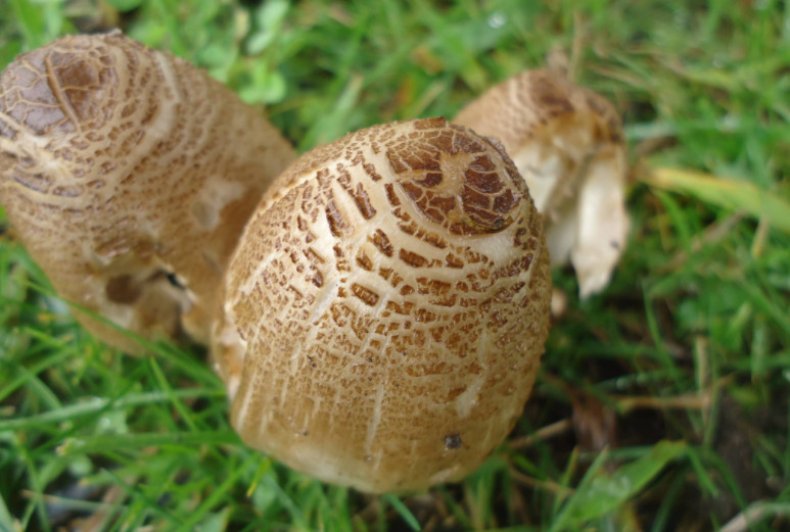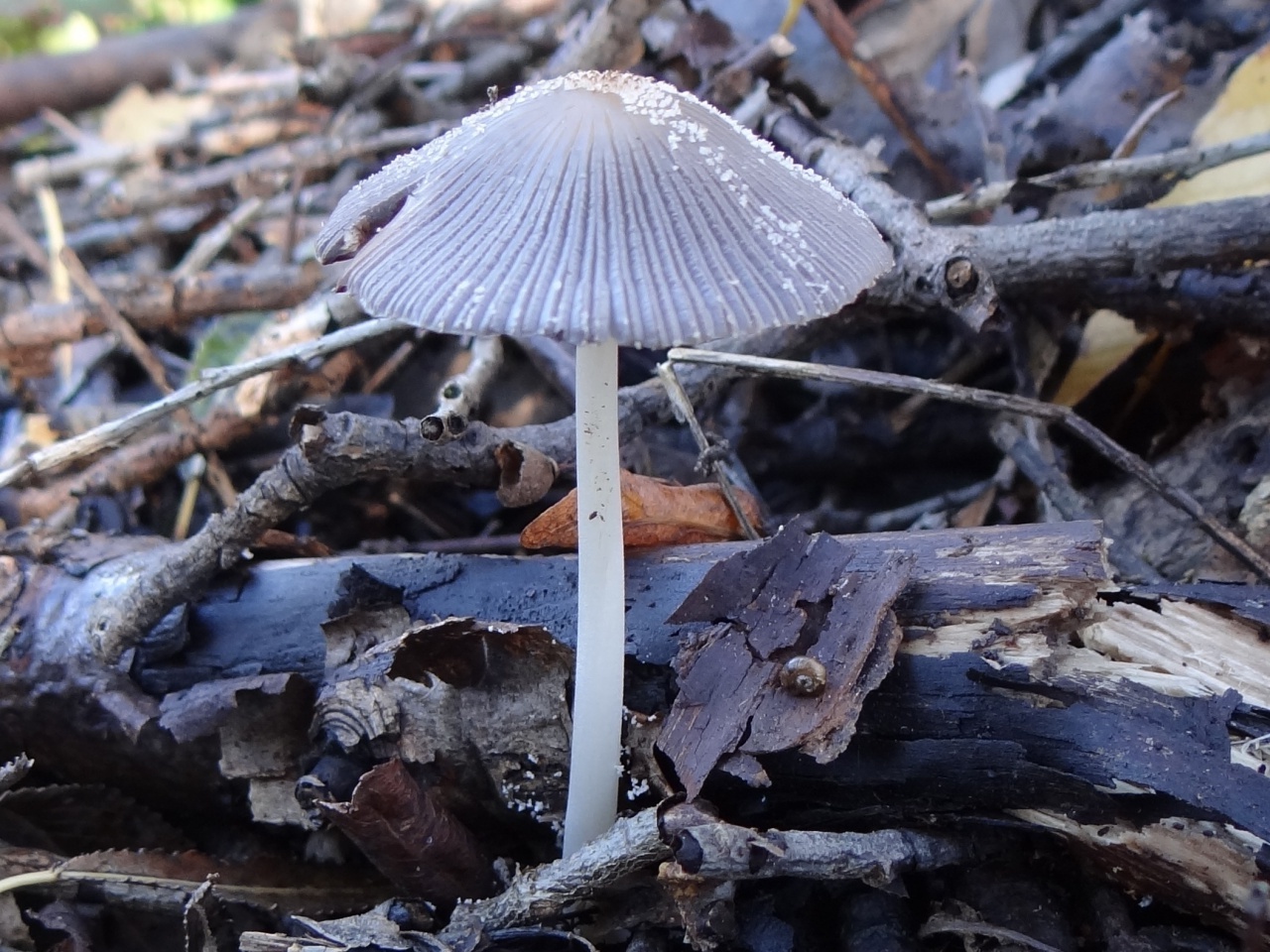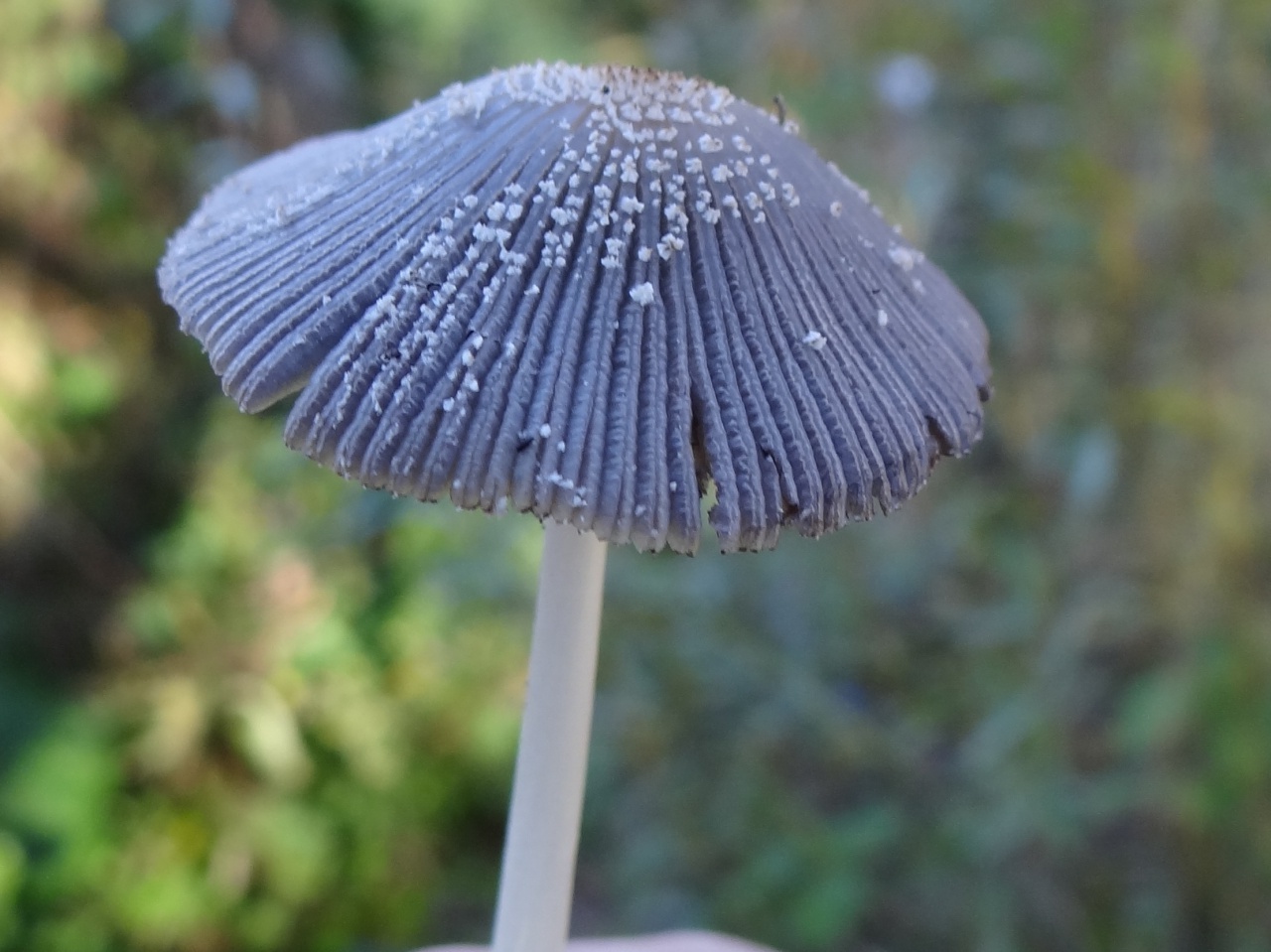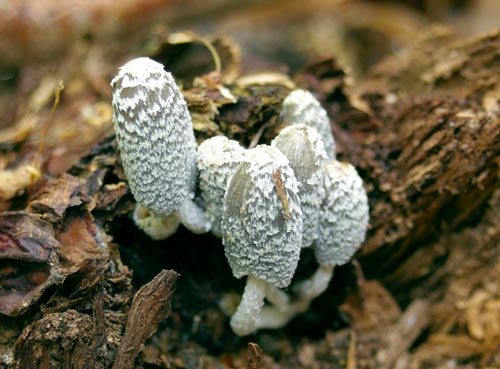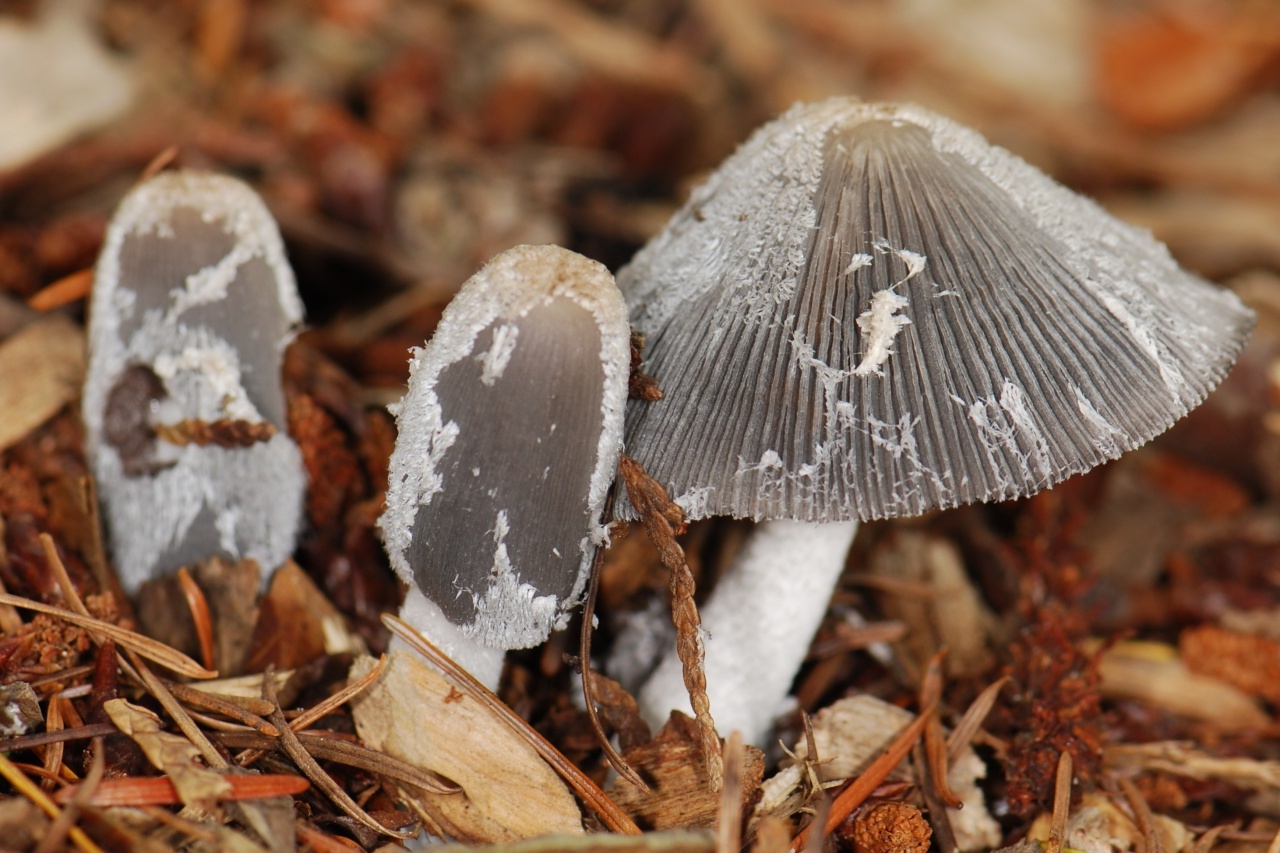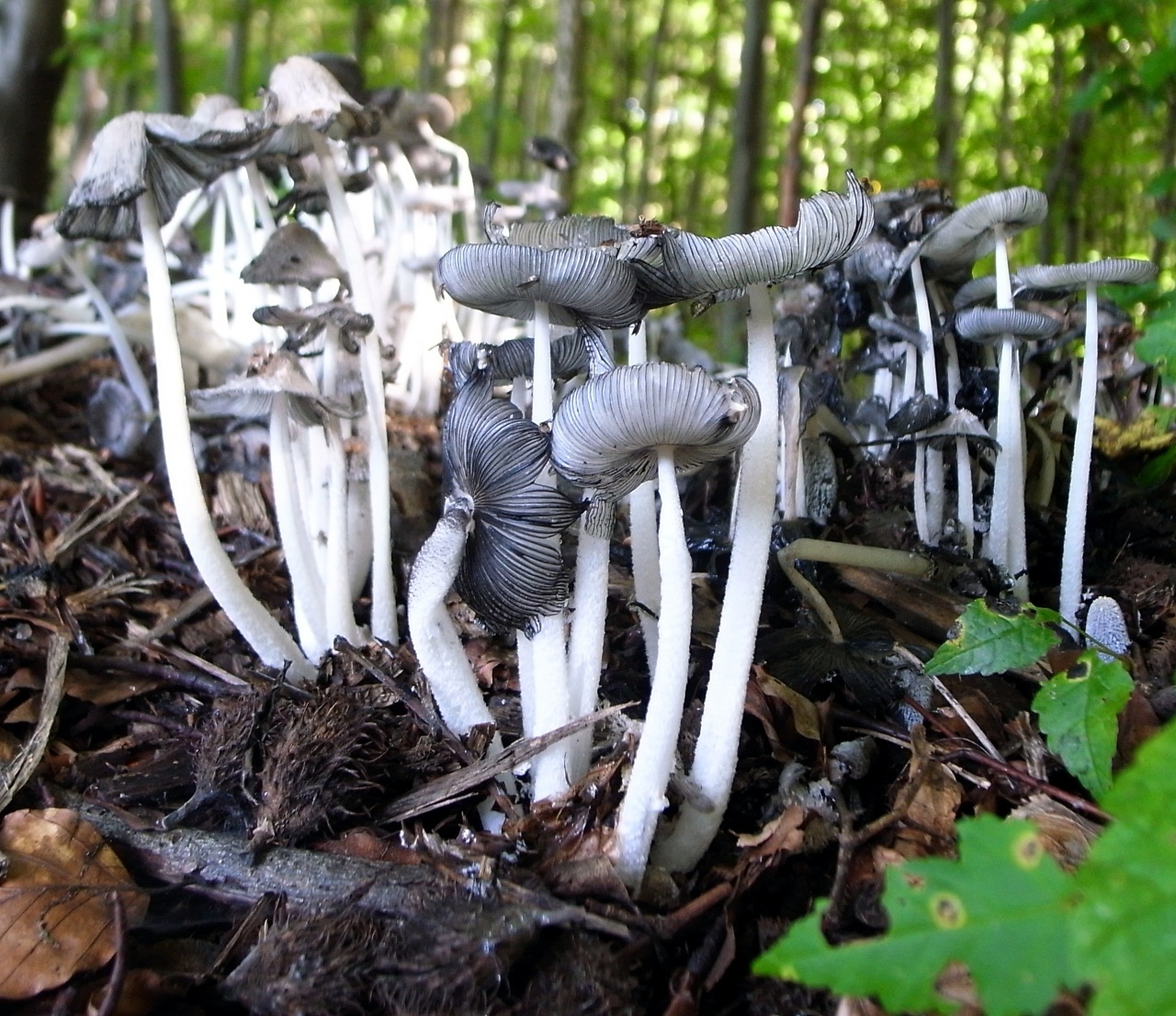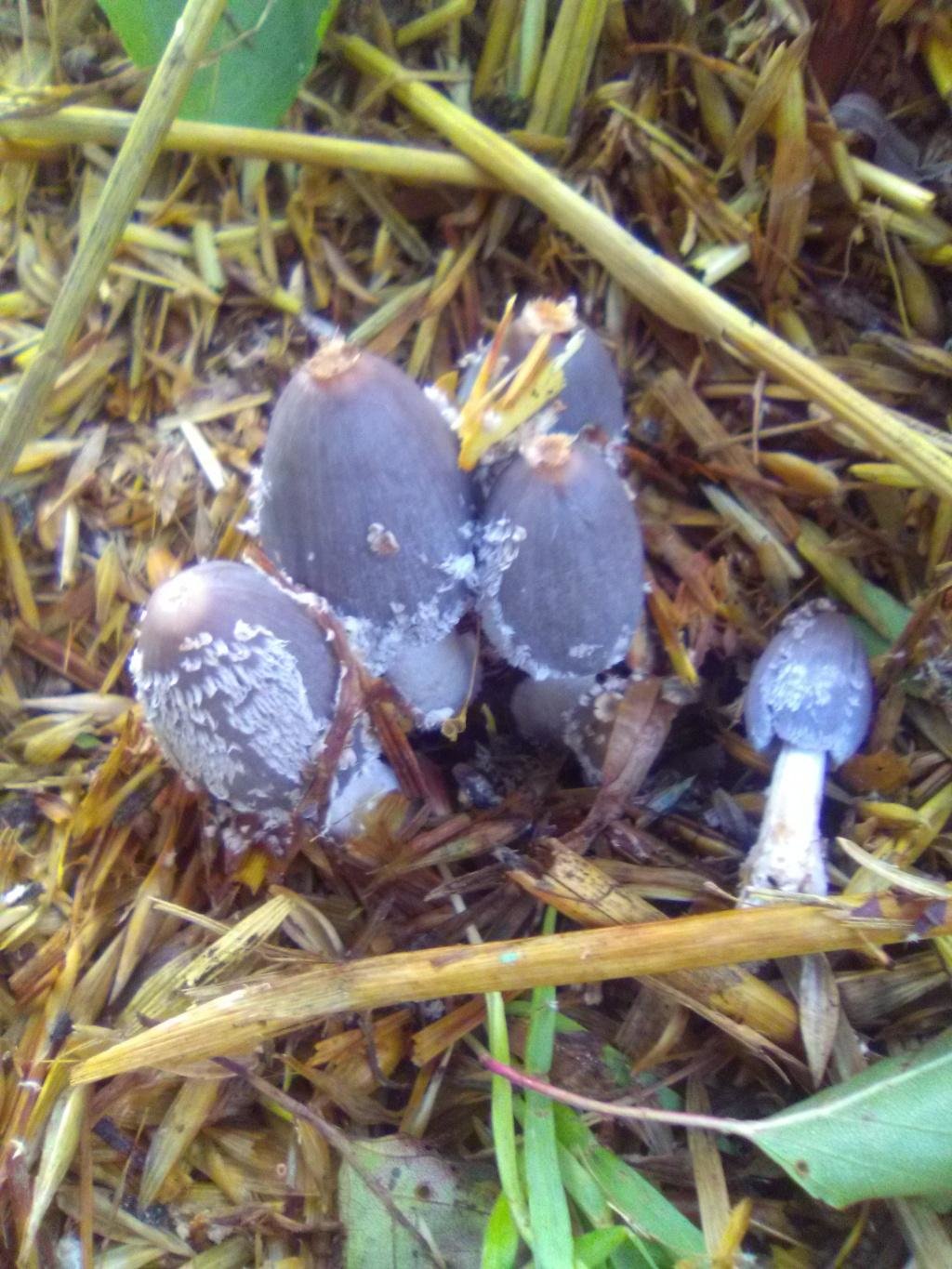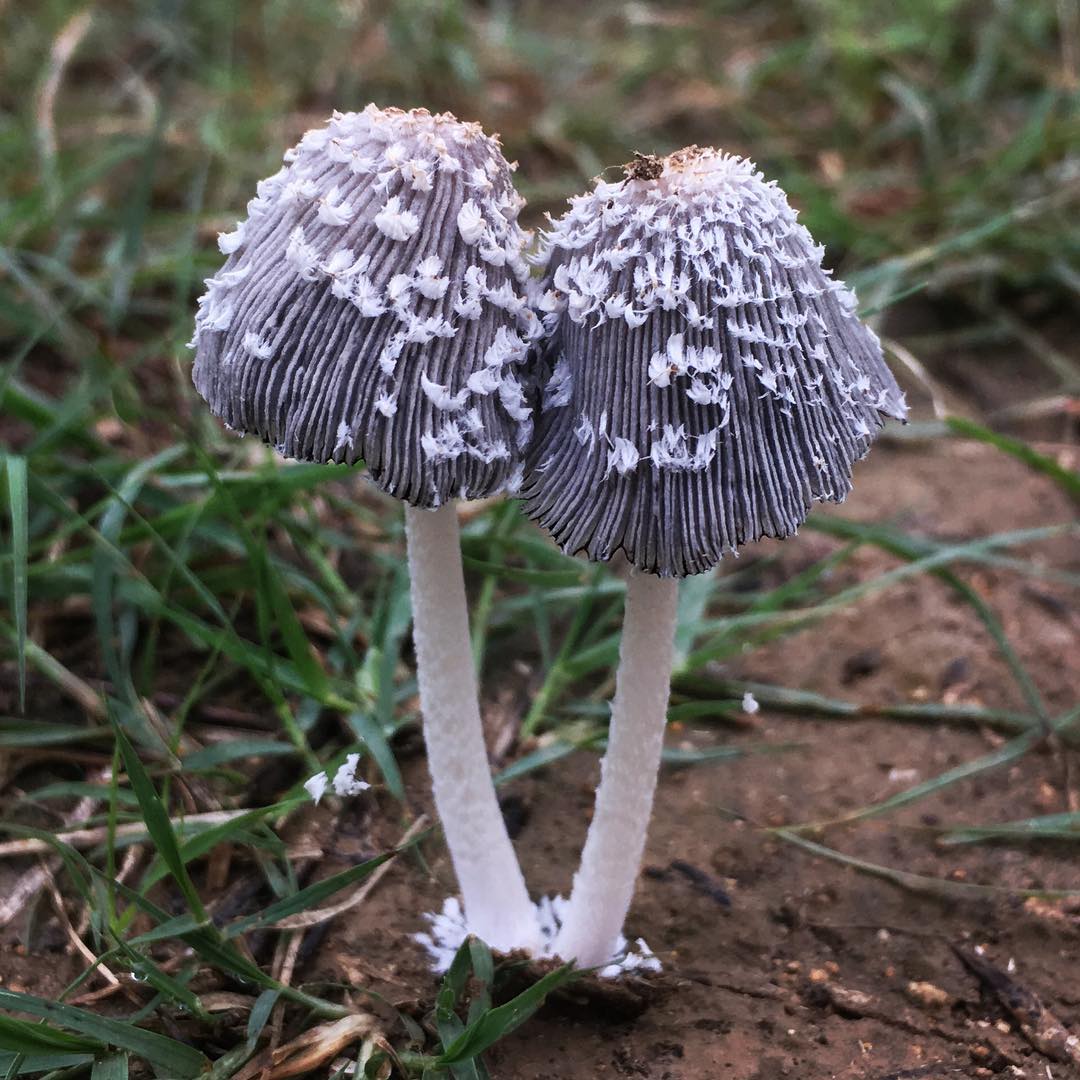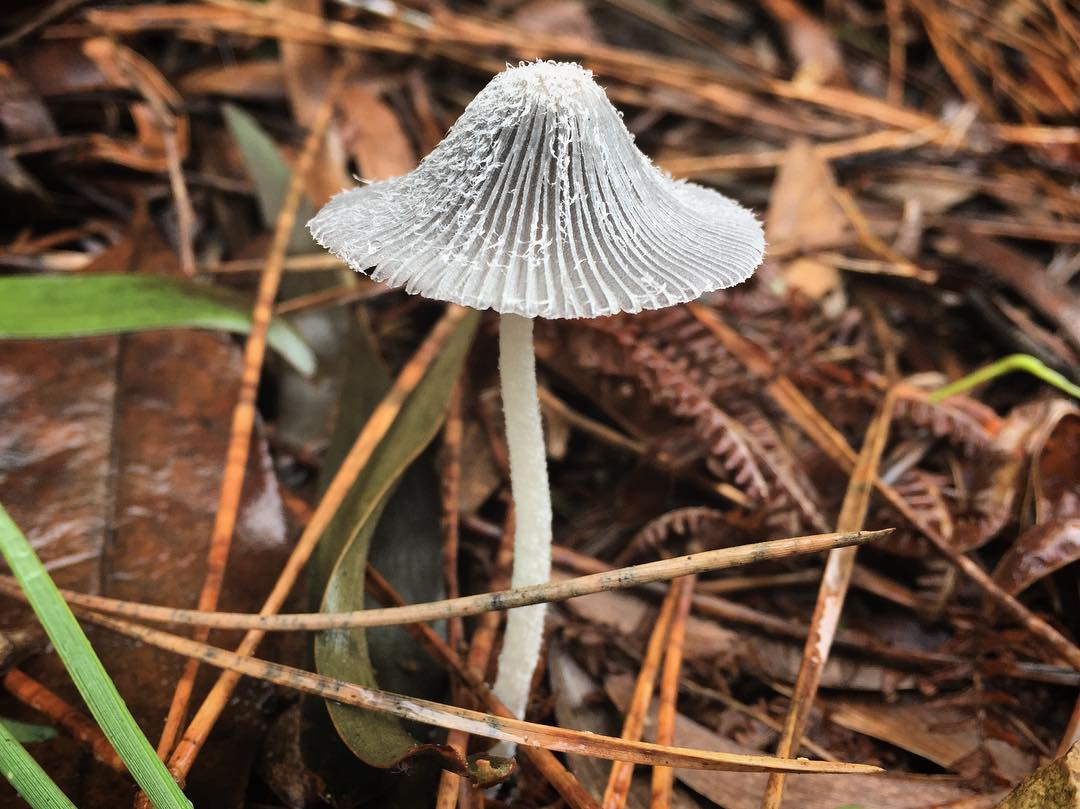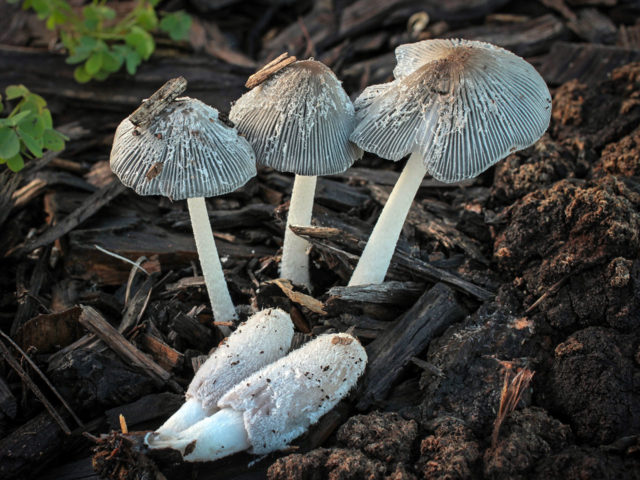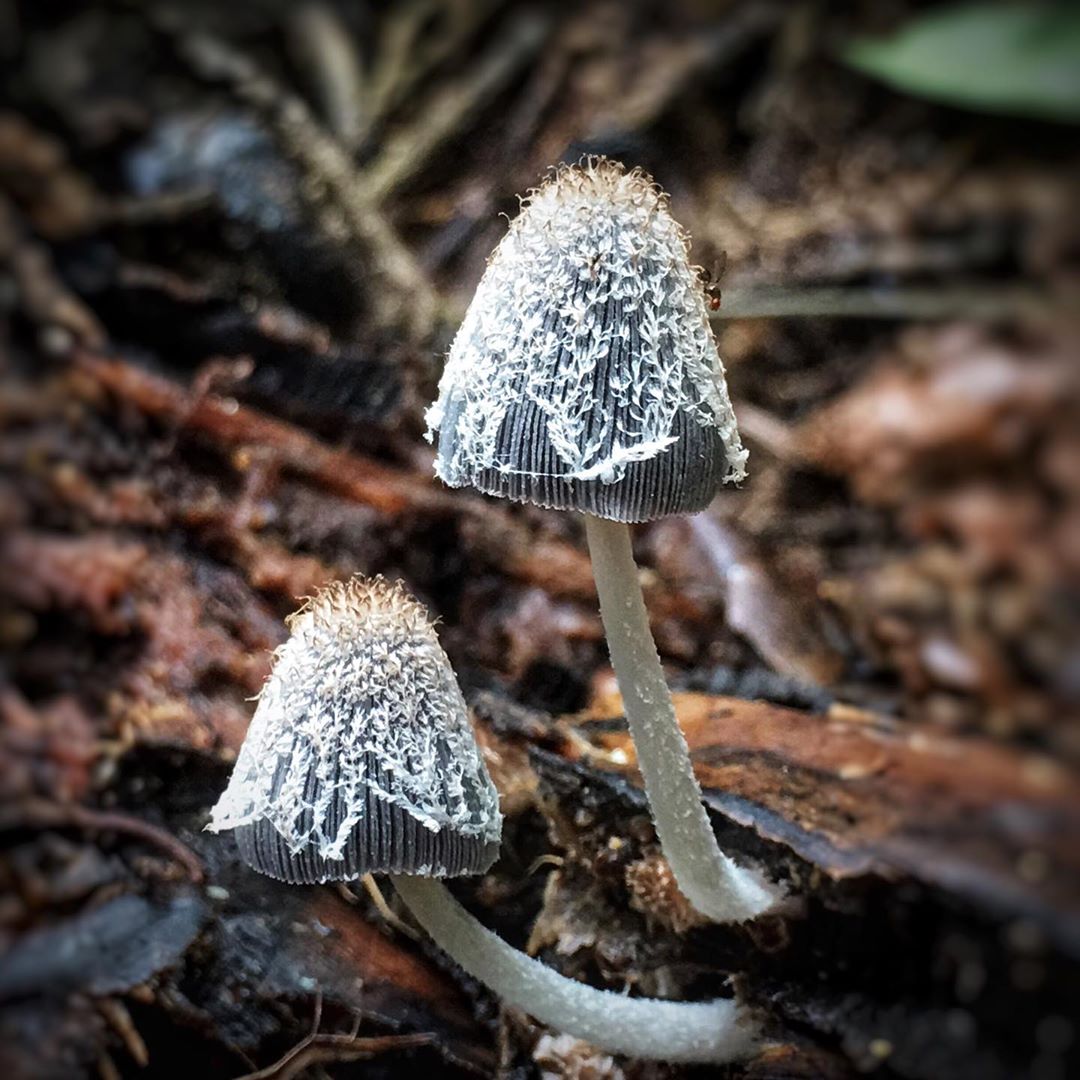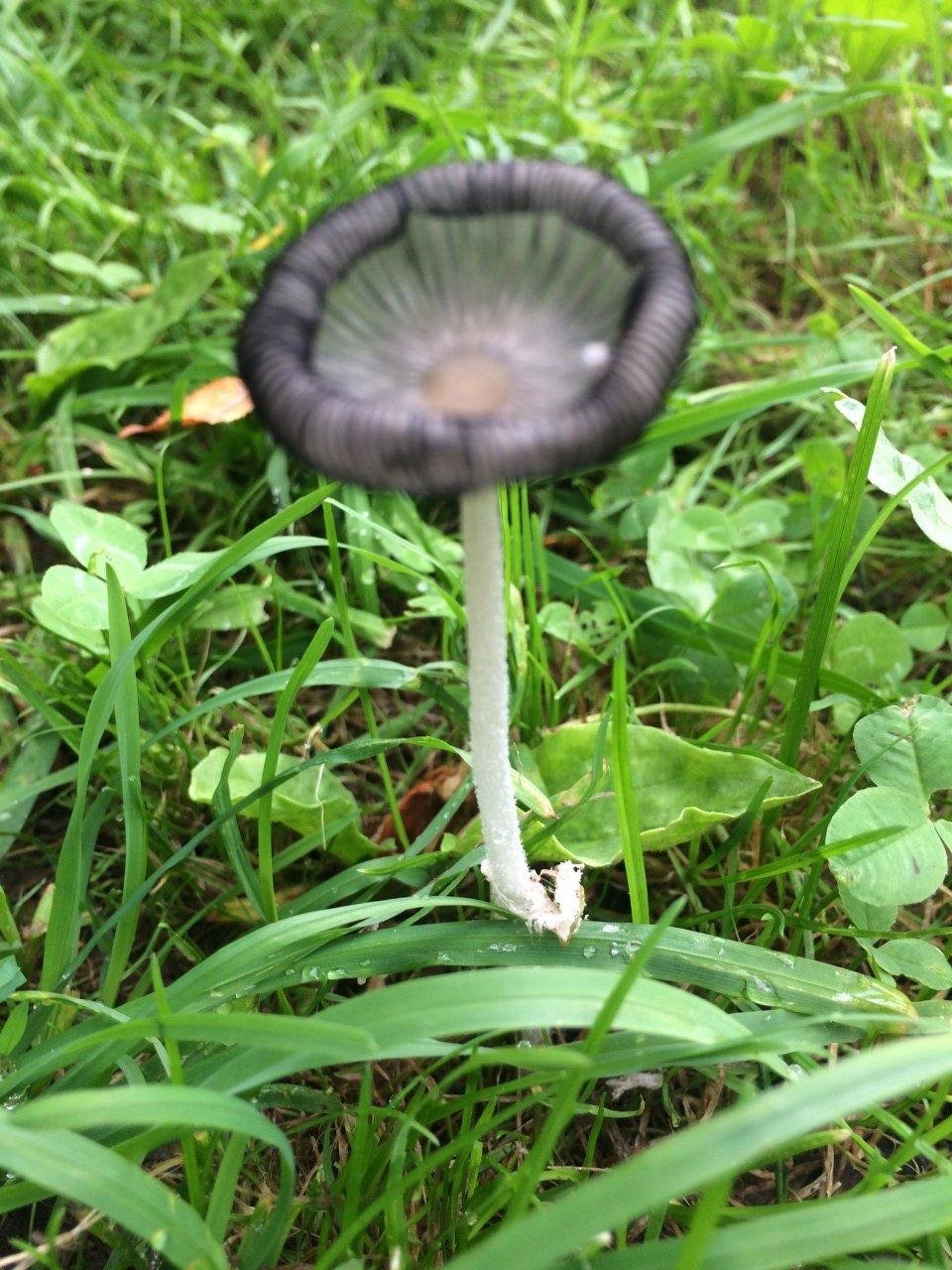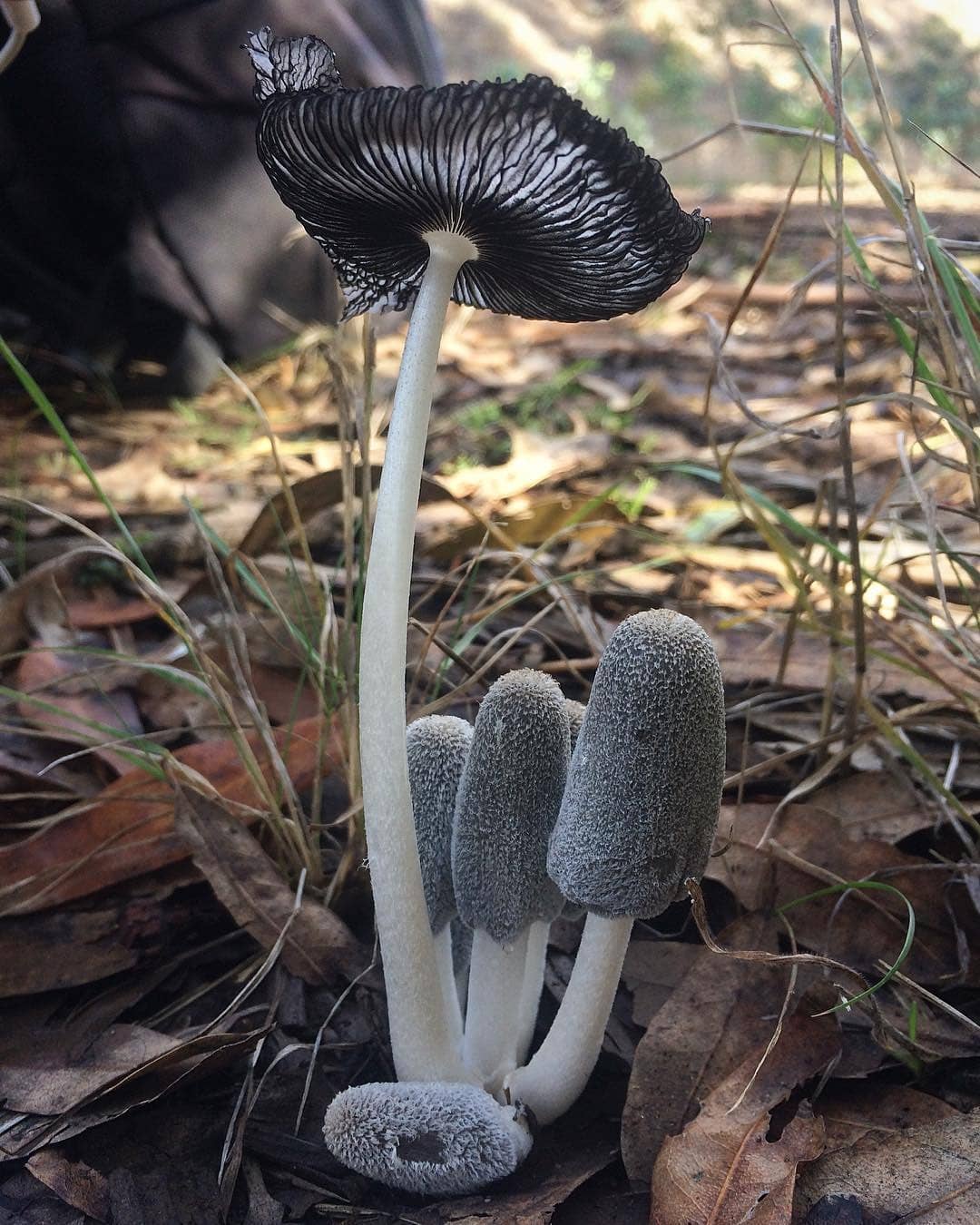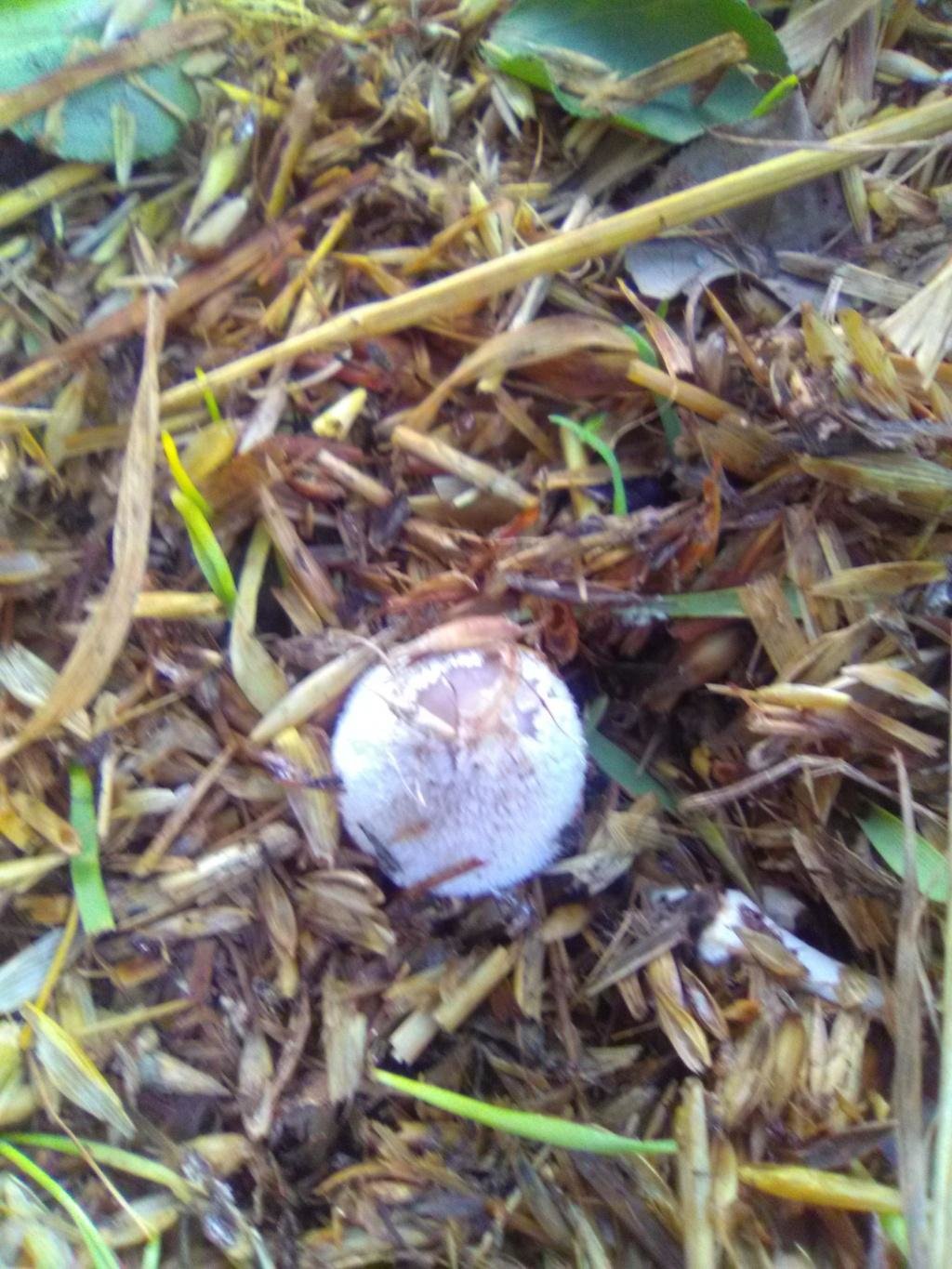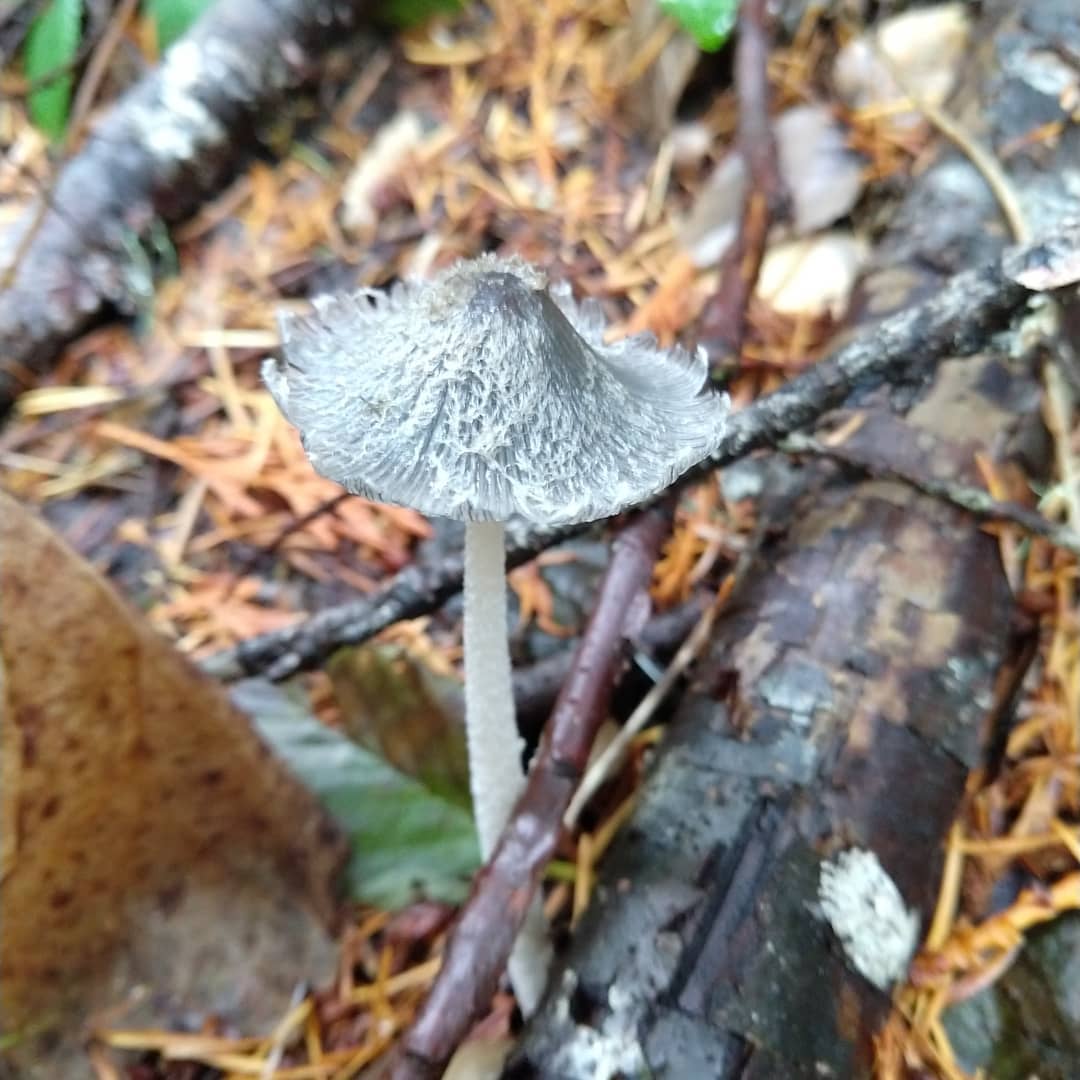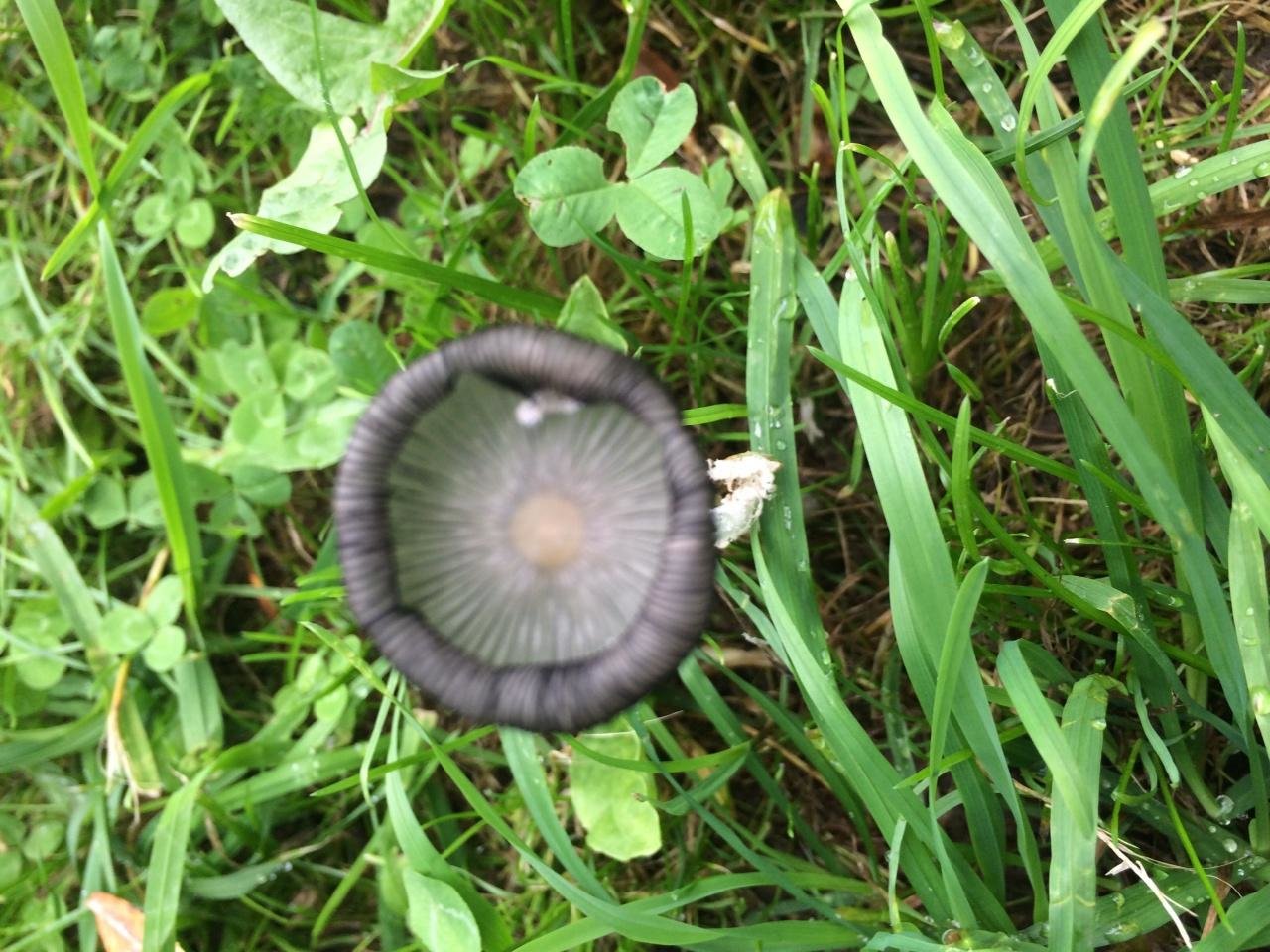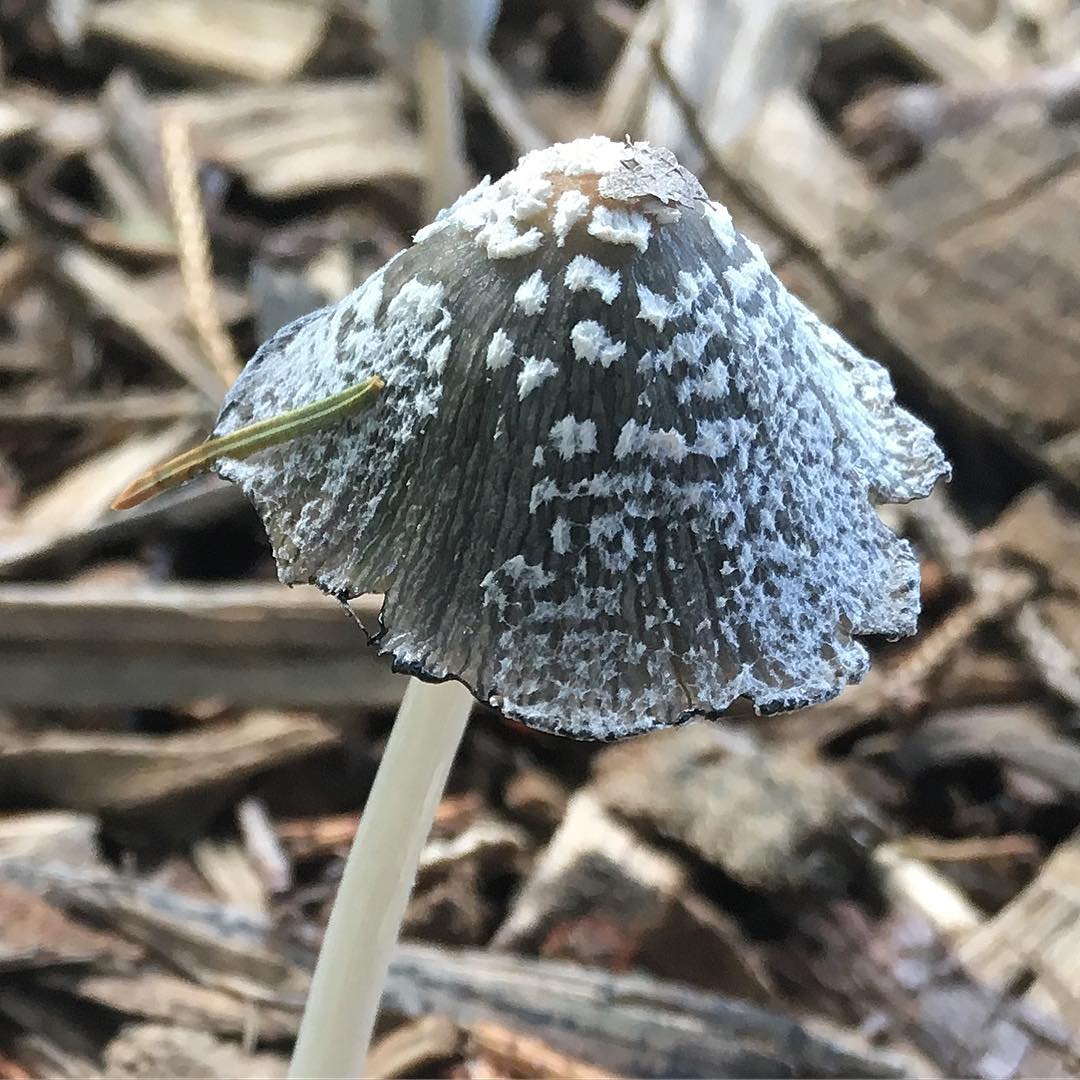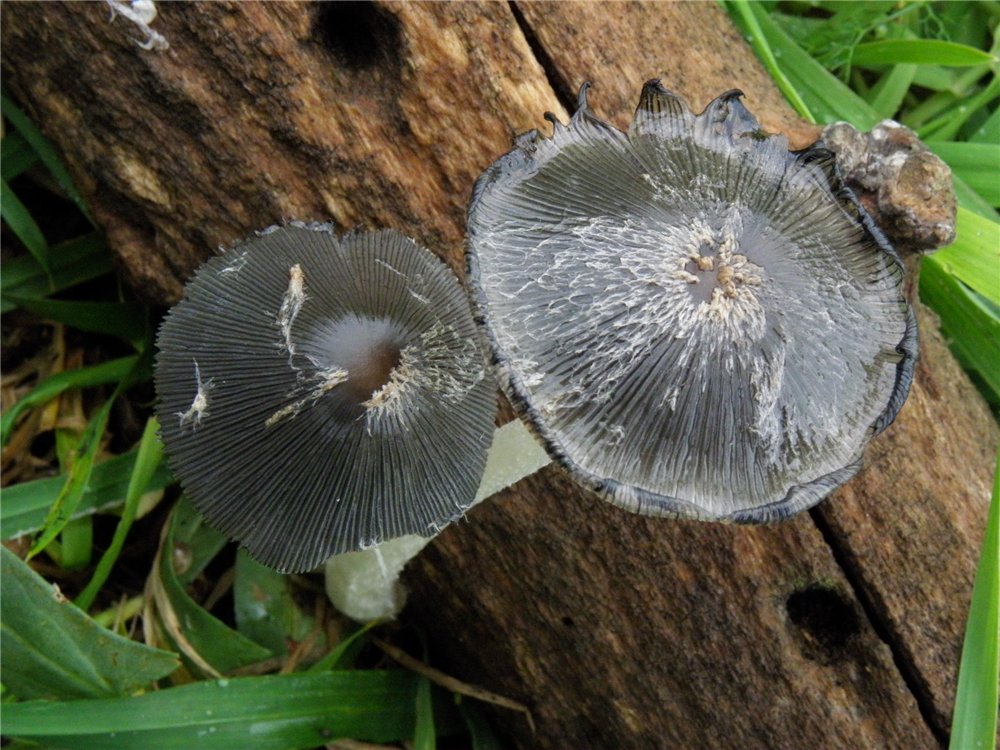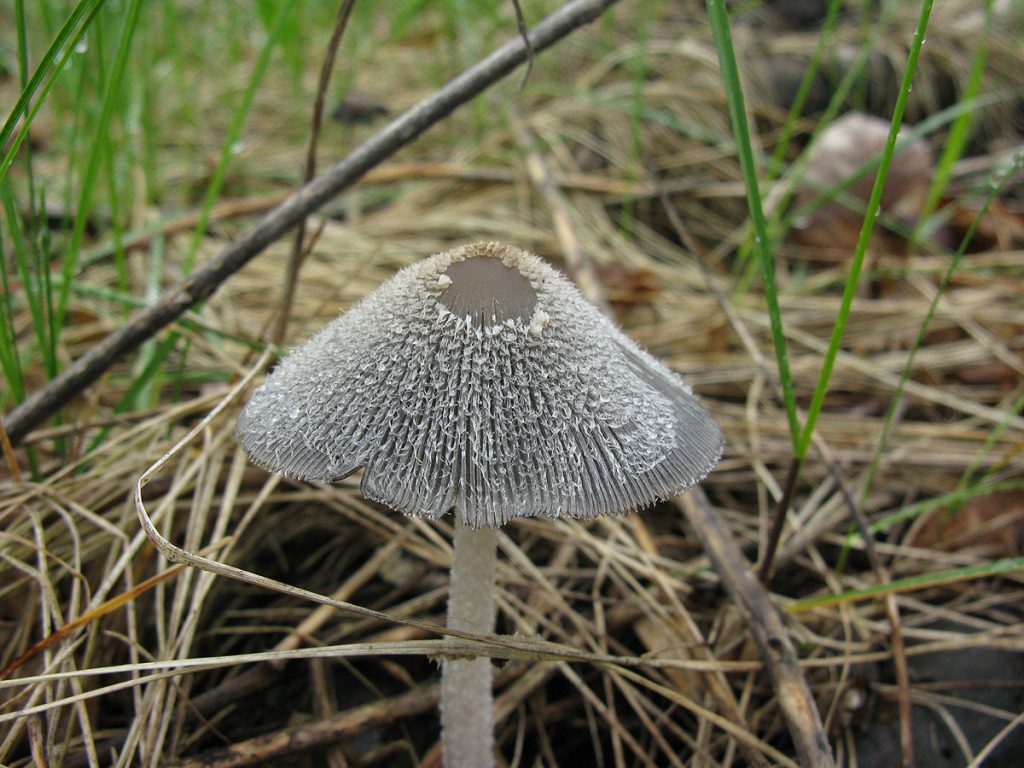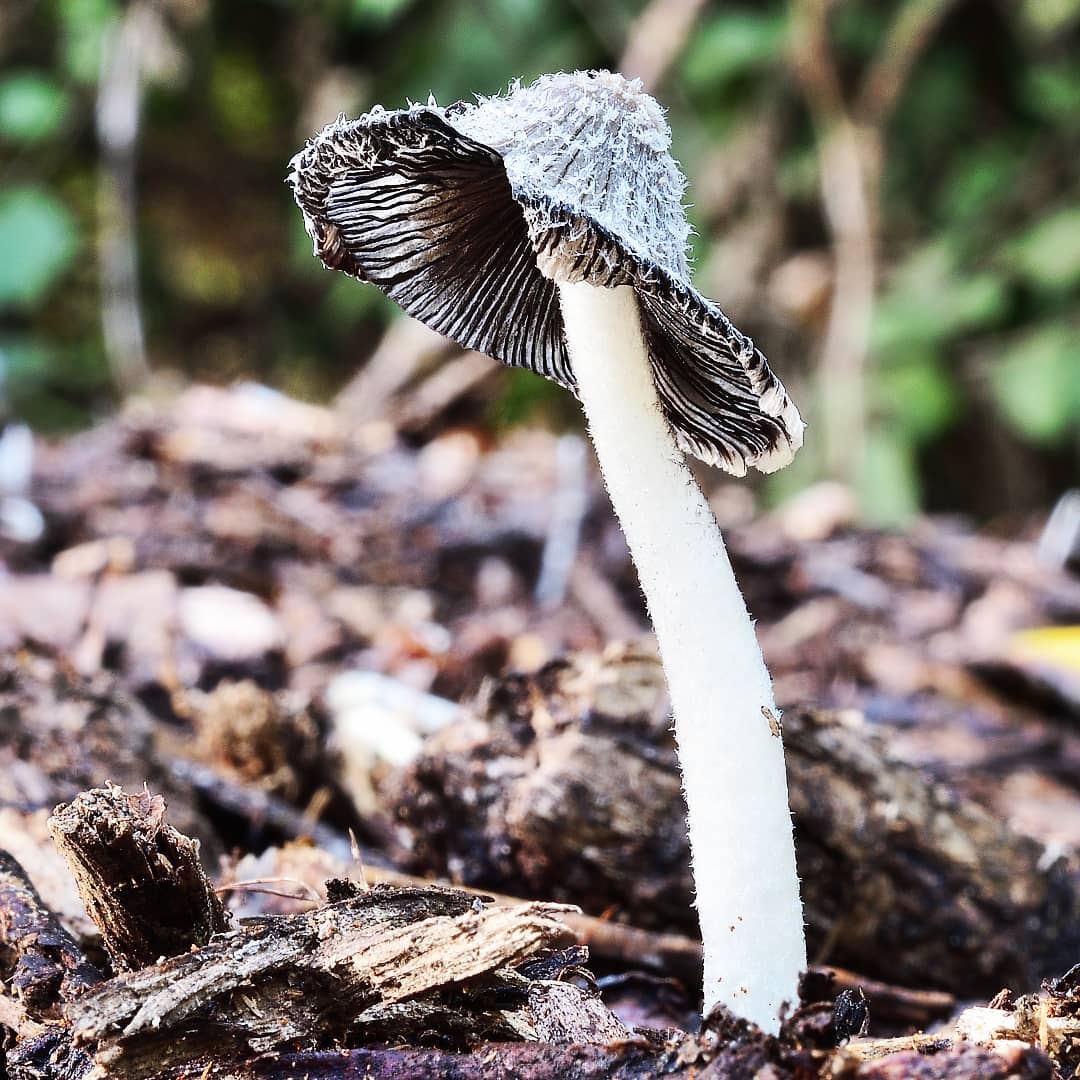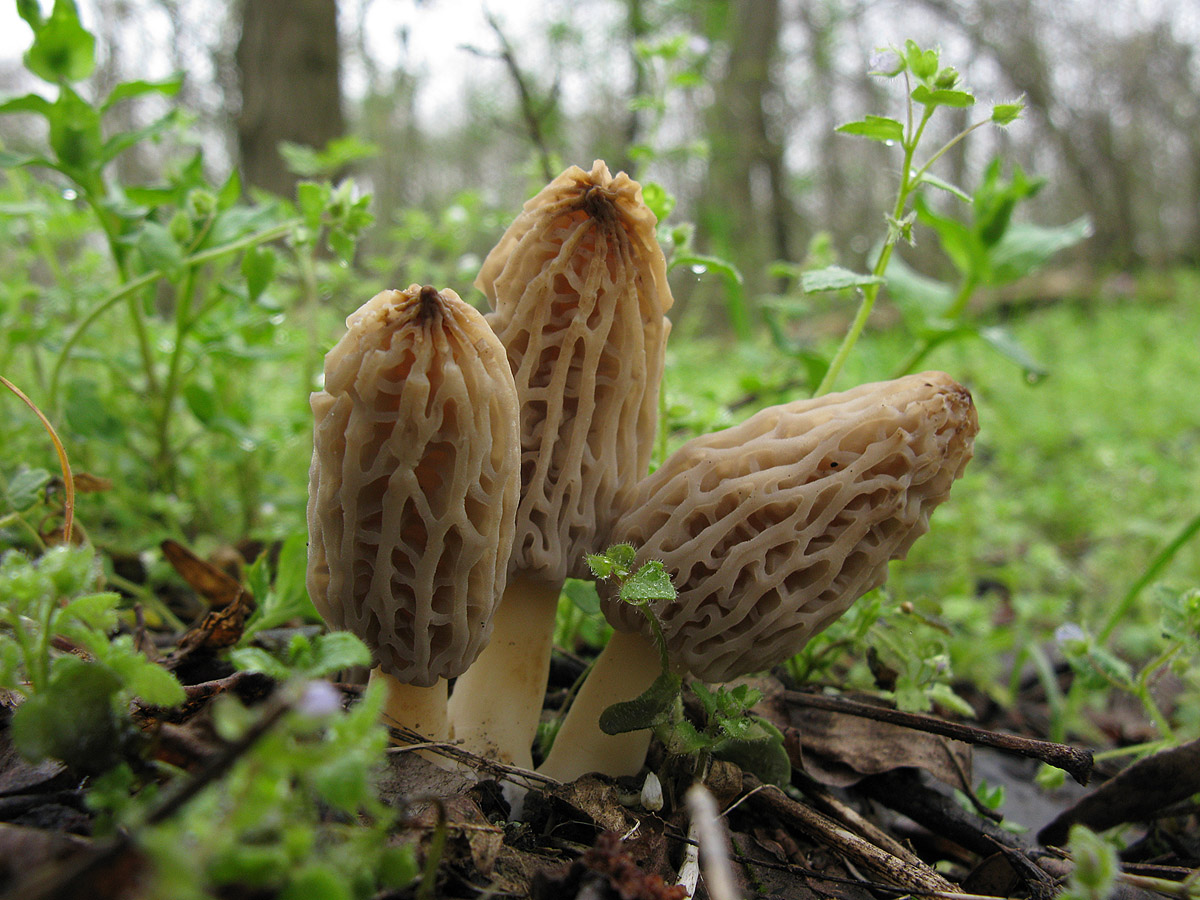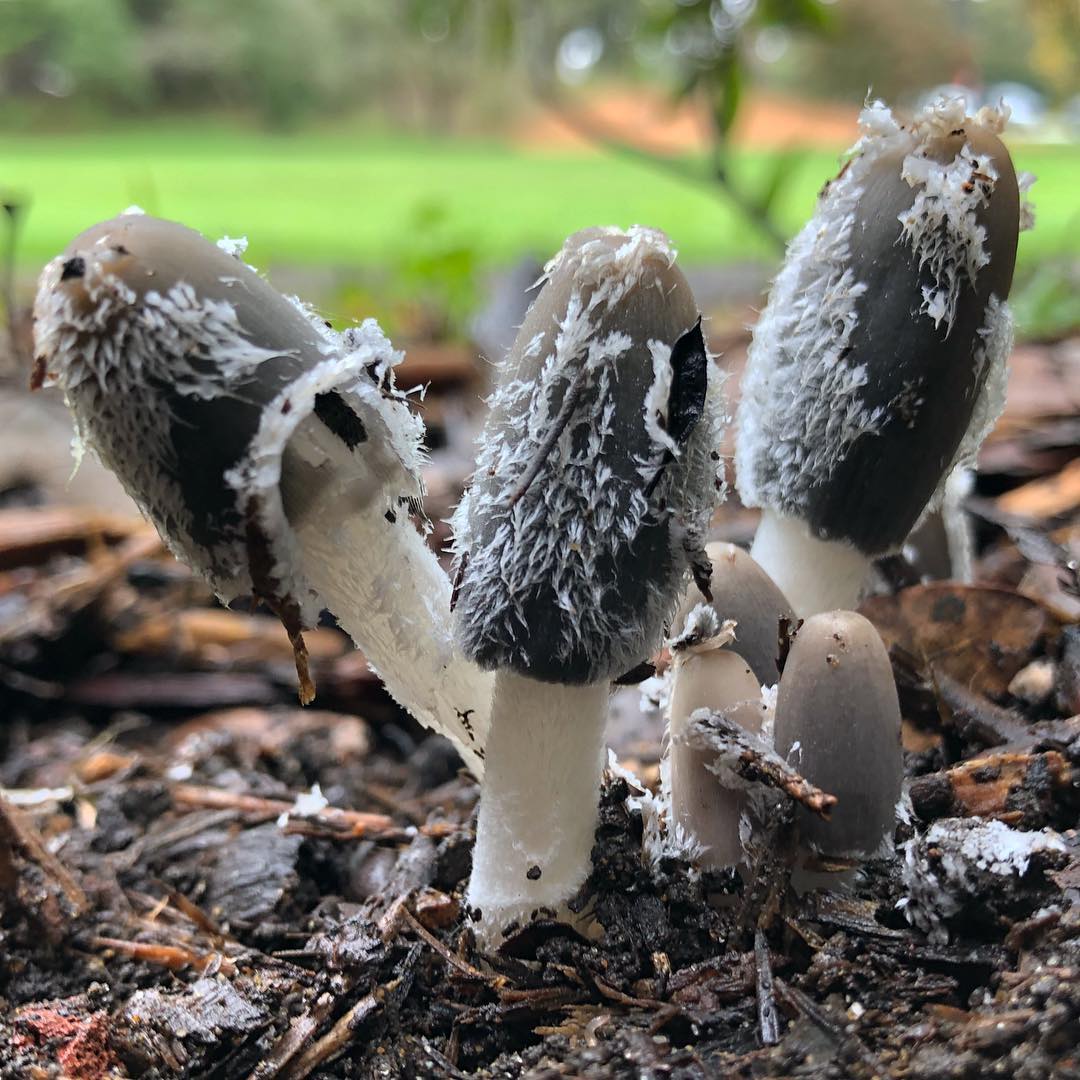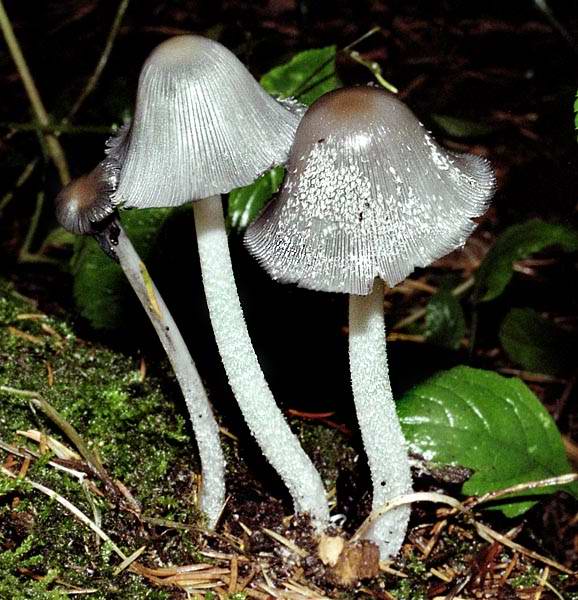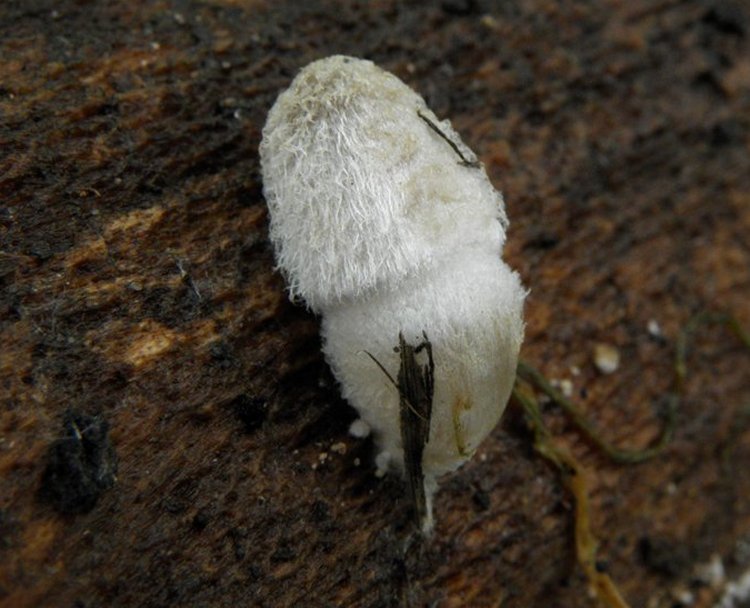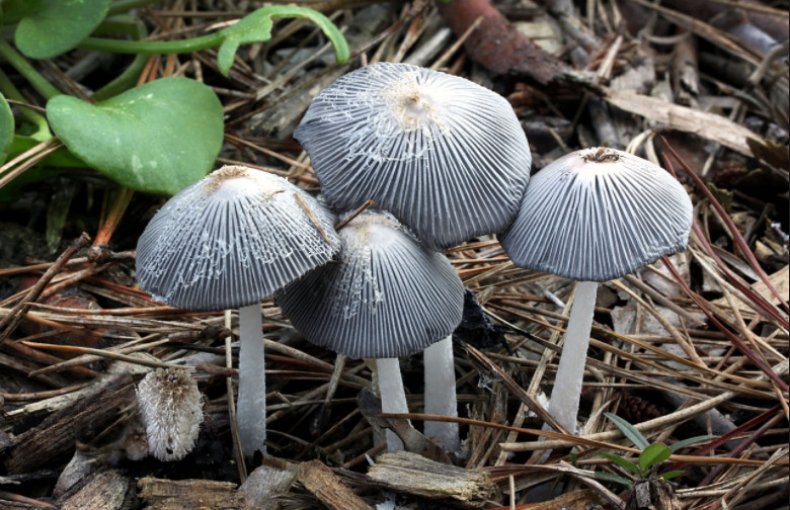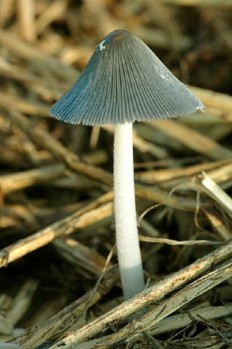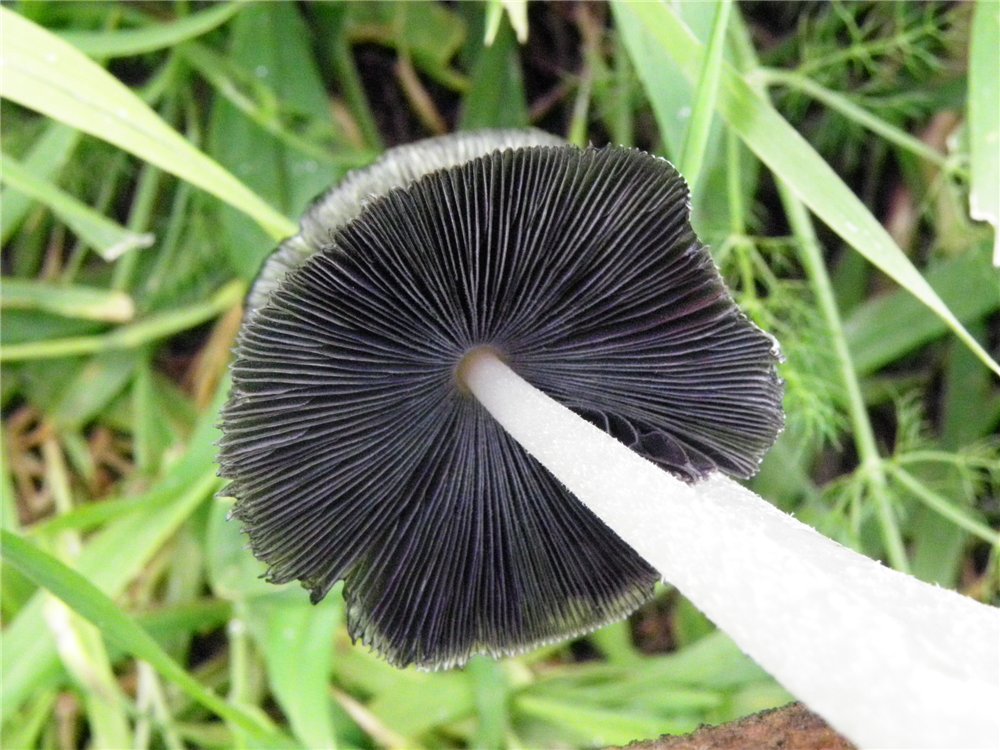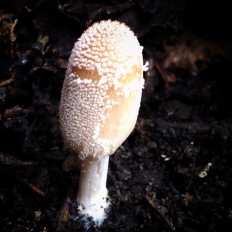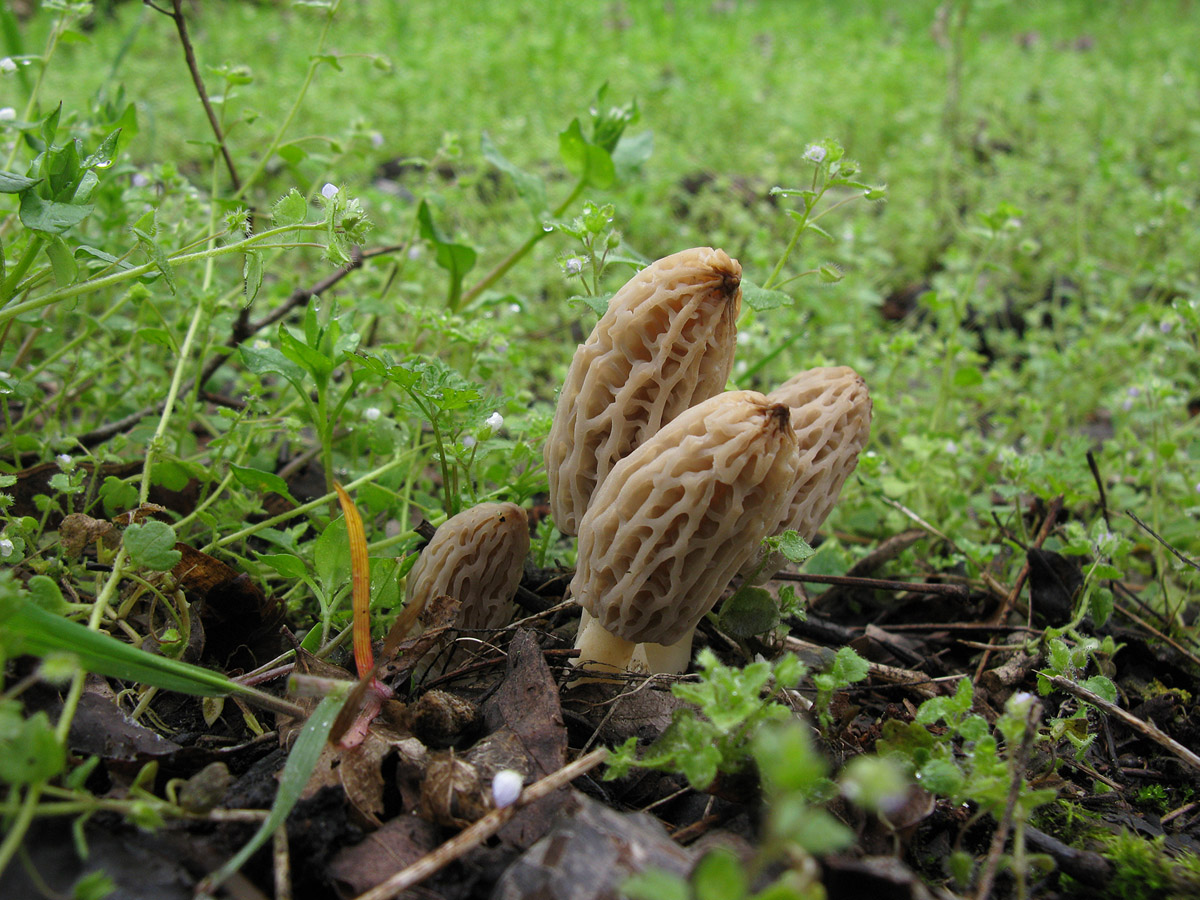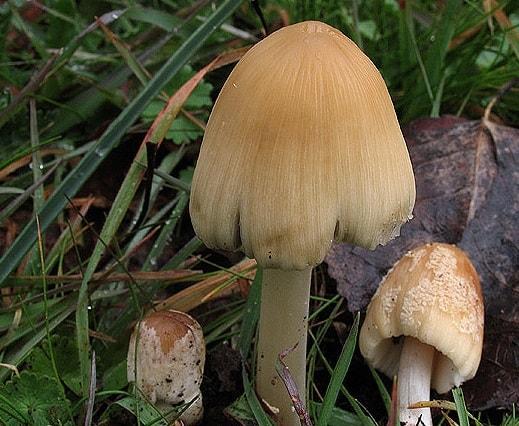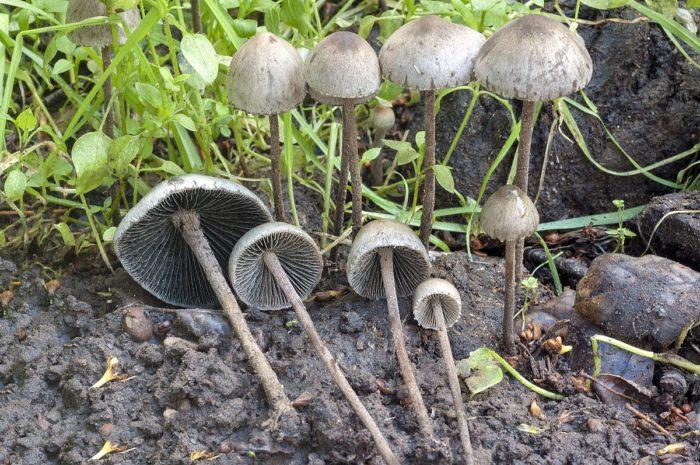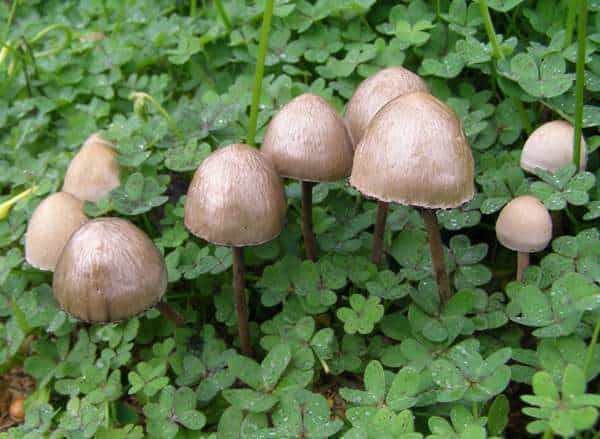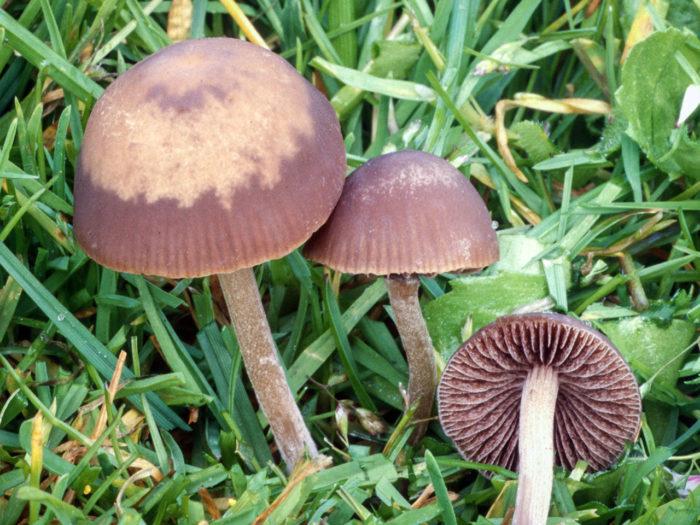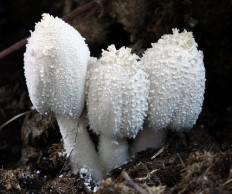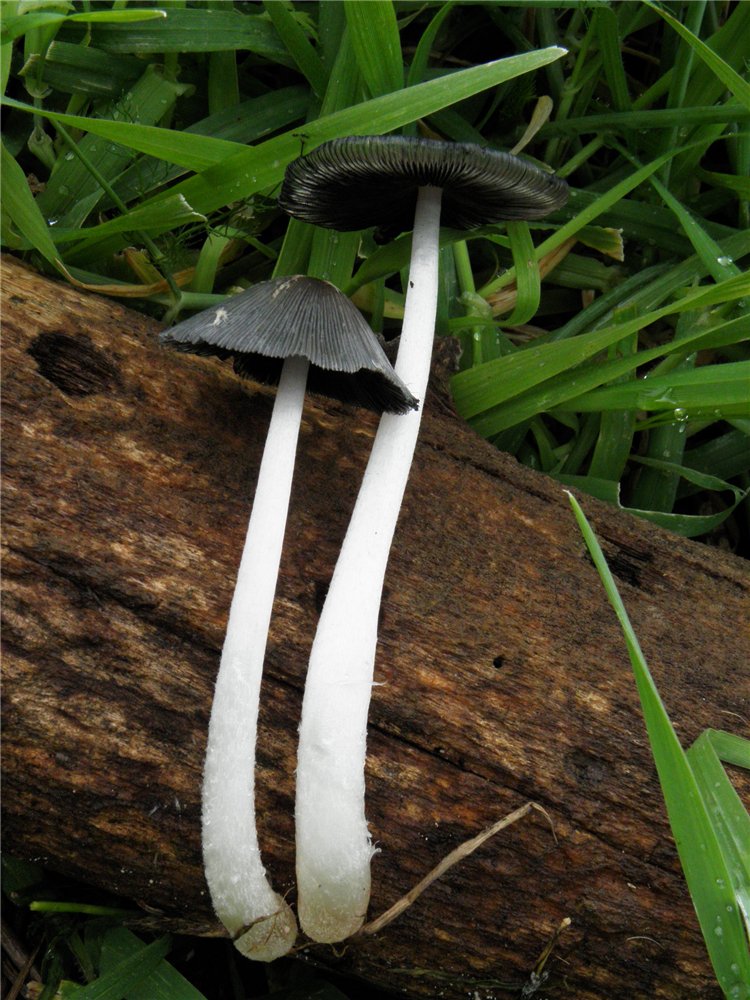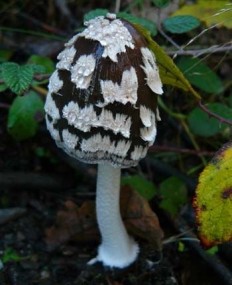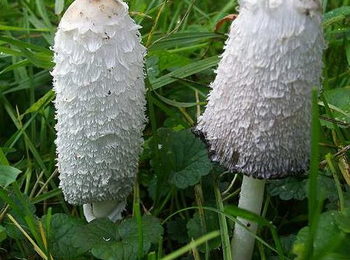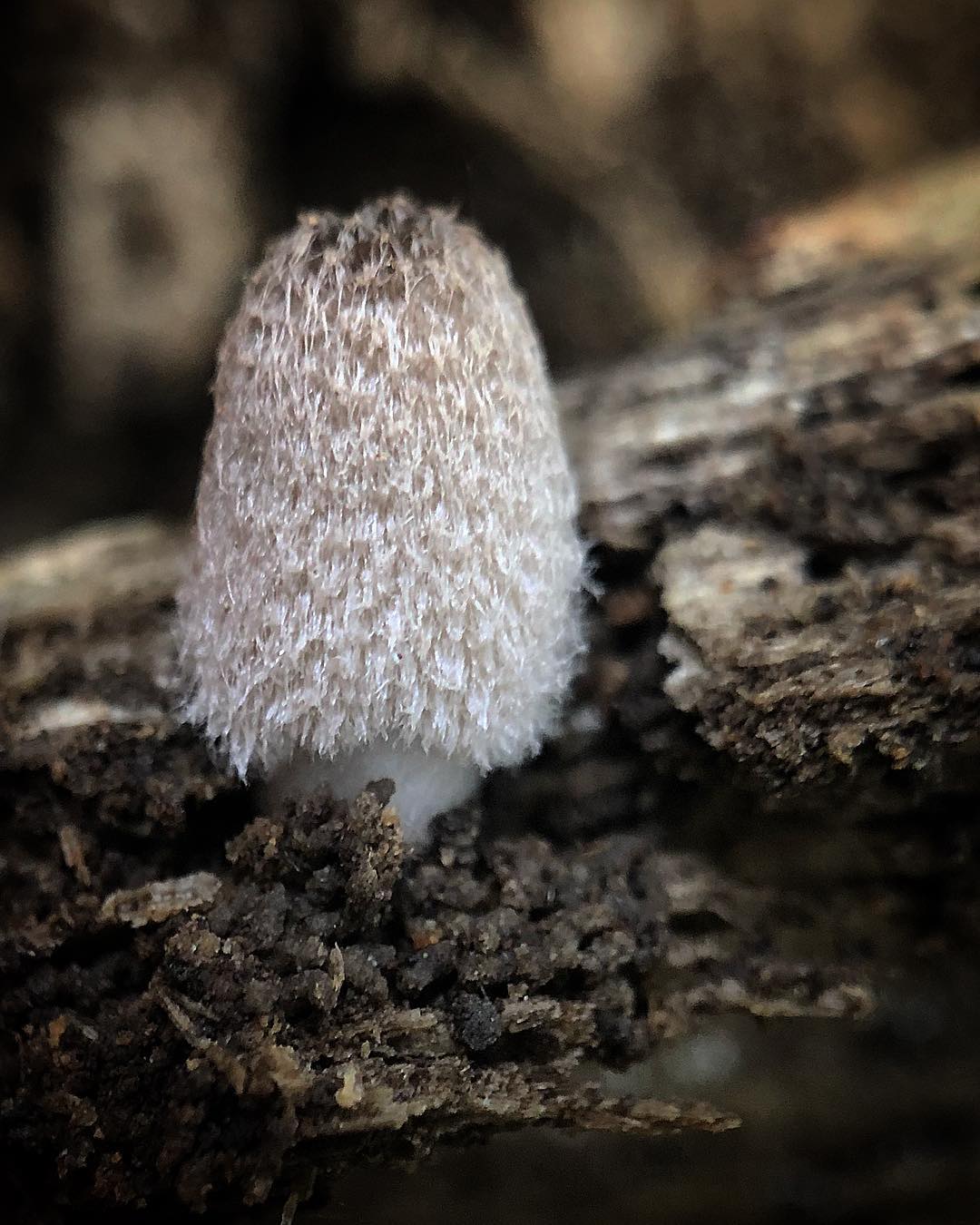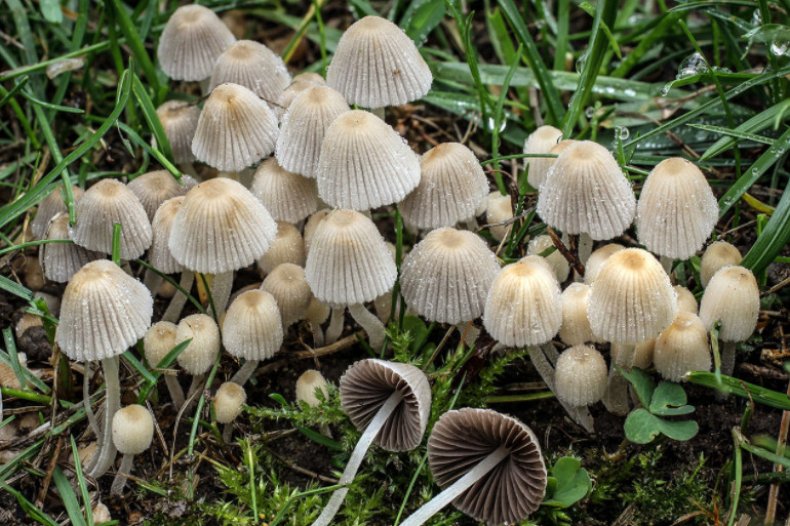Varieties and twins
The species composition of the Koprinus genus is constantly being revised. Some varieties, originally classified as dung beetles, were later isolated into separate genera or even transferred to other families; in relation to others, discussions are still underway.
Of course, there is no need to study and memorize all varieties of dung beetles, it is enough to be able to recognize only the most common of them
In addition, as with other mushrooms, in this case it is very important to know what to confuse Koprinus with, paying, of course, special attention to its inedible and poisonous counterparts.
Dung beetle white
Almost the only species of dung beetle that is unequivocally classified as edible is Coprinus comatus. The appearance of this mushroom is so characteristic that it is almost impossible to confuse it with any dangerous double.
You will be interested to know how to make delicious porcini mushroom soup.
Features:
- height 5–20 cm;
- egg-shaped cap (in young specimens - in the form of a spindle), always closed, snow-white with possible shades of grayish or beige, smooth and darker in the upper part, decorated with flaky scales over the rest of the area (because of this, the second name of the mushroom is shaggy dung beetle) ;
- the leg is white, thin (up to 2 cm) and long (up to 30 cm);
- pleasant "edible" smell;
- very fast growth (4-5 cm per day);
- harvest season - from late spring to mid-autumn;
- the place of growth - roadsides, orchards, vegetable gardens, fields, although it is also found in the forest.
It is worth saying that there is another species of dung beetles with a similar name - Coprinus niveus. He also has a white color, but his cap is smooth and as if dusted with flour, which is easily washed off. This species is classified as inedible.
Video: white dung beetle
Dung beetle gray
It is to the gray dung beetle (Coprinus atramentarius) that the name "ink mushroom" is best suited.
It is characterized by the following features:
- the diameter of the cap is 3–7 cm, the shape changes as it grows from ovoid to bell-shaped;
- the color of the cap is grayish brown, the top is darker;
- thin strips diverge from the top of the cap to the edges, which in adult mushrooms transform into cracks, after which the edges of the cap between these cracks rise up;
- plates are numerous, wide; in young mushrooms they are white, in adults they are brown, and after the onset of autolysis they are black;
- stem height 12–16 cm, thickness 1 cm, structure soft, watery, off-white color along the entire length, and in the lower part with reddish-brown blotches;
- the aroma is pleasant;
- shelf life is minimal: after collection, complete autolysis occurs in just a few hours.
Coprinus atramentarius is classified as a conditionally edible mushroom.
Video: gray dung
Romanesi dung
Another common species is very similar to gray dung beetle - Coprinopsis romagnesiana. Its main difference is a more pronounced "shaggy" (according to this quality, the Romagnesi is similar to the white dung beetle). The scales are dark brown with a possible tint towards orange or brown. In young mushrooms, the "fringe" fits tightly to the cap, but as it ripens, it becomes more fluffy at the edges. The leg is white, with a slight hairiness and, in some cases, with a seal in the lower part.
Check out the recipe for stewed potatoes with mushrooms.
The average size of the fungus is 6–12 cm in height, the thickness of the leg is up to 1.5 cm. Another feature by which Coprinopsis romagnesiana can be distinguished from gray dung beetle is the almost complete absence of smell (as well as taste). The fruiting period usually occurs in spring and summer, but there are repeated periods of appearance of these mushrooms in the second half of autumn.Like gray dung beetle, Coprinus romanesi is conditionally edible.
Dung beetle twins
In addition to those mentioned above, in the literature you can find descriptions and photographs of the following varieties of dung beetle and its counterparts:
| Russian name | Latin name | Consumer properties (according to various sources) |
| ordinary, or ash gray | coprinus cinereusc | conditionally edible |
| shimmery | coprinus micaceus | conditionally edible / inedible |
| home | coprinus domesticus | inedible |
| absent-minded | coprinellus disseminatus | inedible |
| narcotic | coprinus narcoticus | inedible |
| fluffy, or furry | coprinopsis lagopus | inedible |
| folded | parasola plicatilis | inedible |
| resinous, or magpie, or variegated | coprinopsis picacea | inedible |
| willow | coprinellus truncorum | inedible / poisonous |
Koprinus species
White dung beetle (Coprinus comatus)
The mushroom is 5–15 cm high. The cap is white, covered with scales. Because of this, the white dung beetle is also called shaggy. The shape of the cap is fusiform at a young age. Later, it unfolds in the form of a bell.
The lower plates are thin white, darkening with age. The leg is thin, smooth, hollow, up to 10 cm high.
White dung beetle is widespread. It grows from spring to autumn in the forest, in the fields, in kitchen gardens, orchards and along the roads.
White dung beetle is edible and tastes good. Mushrooms are harvested at a young age and processed quickly. Cut white dung beetles are not stored for a long time.
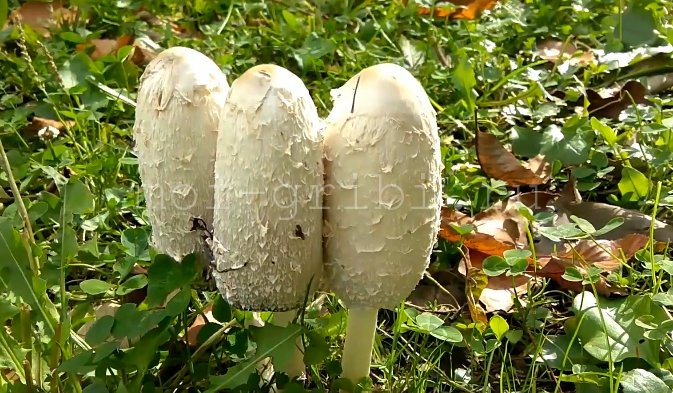
Gray dung beetle (Coprinopsis atramentaria)
A mushroom with a gray or grayish-brownish cap. The hat is covered with dark scales. The shape is ovoid at a young age, then opens in the form of a bell with cracked edges. The stem is white, hollow, darkish at the base, 1–2.5 cm in diameter.
The lower plates are wide, white, darkening with age. It is found almost everywhere from April to November. It prefers to grow in damp places, gardens, fields, compost heaps and decaying wood debris. Most often it grows in groups.
Belongs to the category of conditionally edible mushrooms. Before use, the gray dung beetle must be boiled. The taste of the mushroom is sweetish, there is no smell.
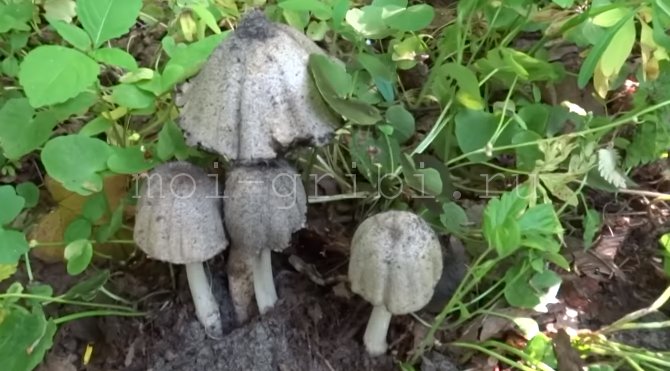
Shimmering manure (Coprinellus micaceus)
A mushroom with a bell-shaped or egg-shaped cap. The cap itself is 2–4 cm in diameter, furrowed, grayish-brown, more dark at the apex, covered with small shiny scales. The stem is thin, fibrous, hollow, fragile. The lower plates are thin, adherent, white, darkening with age.
It is found almost everywhere. It grows in groups or intergrowths from May to November on decaying wood, as well as in parks, gardens, pastures, etc.
An inedible mushroom, although it is also not considered poisonous.

Willow dung (Coprinellus truncorum)
A mushroom with an ovoid whitish cap. The grooves on the cap are more pronounced than those of the shimmering dung beetle. The edge of the cap is uneven, split. The leg is long, thin, smooth, white, hollow inside. The lower plates are thin, wide, light, darken and turn brown with age.
The fungus is widespread. It grows from spring to autumn almost everywhere.
Willow dung beetle is not considered poisonous, but it is not eaten.
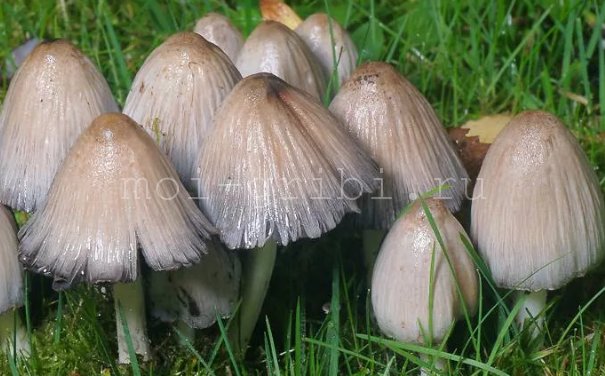
Dung beetle (Coprinopsis picacea)
A mushroom with an elongated large egg-shaped cap covered with white scales. The cap opens with age, taking on the shape of a bell. The leg is light, thin, hollow, up to 20 cm in height, about 2 cm in diameter, has a slight plaque. The lower plates are light.
Grows singly or in groups on decaying organic materials.
The resinous dung has an unpleasant odor and is not eaten.

Folded manure (Parasola plicatilis)
A mushroom with a yellowish closed cap 1–3 cm in diameter, which brightens and opens with age. The surface of the cap is folded. The leg is 5–10 cm in height, thin, smooth, light, fragile. The lower plates are grayish, thin, attached.
Distributed almost everywhere.
The folded dung beetle has a very short life span - about a day.The fragile leg cannot withstand the weight of the cap, and the mushroom breaks and dies.
It is not considered poisonous, but it is not eaten.
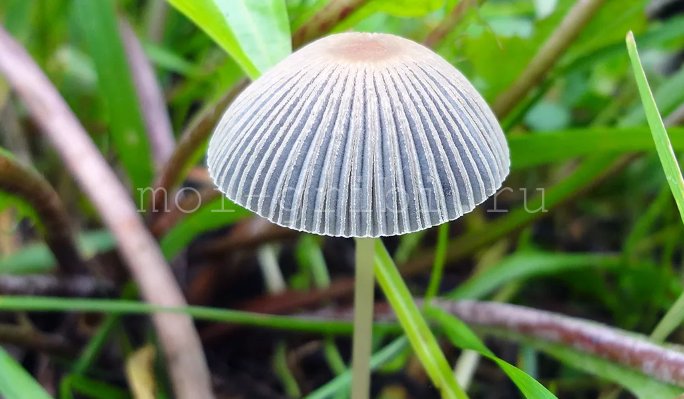
Taxonomy
The genus is described by H. Person and attributed by him to the family of lamellar, or agaric mushrooms (Agaricaceae). In the first half of the 20th century Coprinus became a type genus of the Dung family (Coprinaceae), which included several more genera, similar in some features of the structure of fruit bodies and ecology. Phylogenetic studies at the end of the 20th century revealed the heterogeneity of dung beetles, and the genera included in this family were distributed among other families. Most species of the genus Coprinus were transferred to childbirth Dung (Coprinellus), Coprinopsis and Parasola families Psatirella (Psathyrellaceae), the rest are considered to belong to the Agaric family, according to Person. The composition of the genus is being actively revised. In the 10th edition of the Ainsworth and Bisbee Dictionary of Mushrooms (2008), the number of species is indicated at about 10; according to the 2010 checklist, the number of species is about 25.
How to grow dung mushrooms correctly?
Dung beetles can be grown both indoors and outdoors. Due to its unpretentiousness, the mushroom grows well and bears fruit. It is practically not affected by diseases and pests.
Subject to certain rules, you can get a good harvest of mushrooms on your site:
- When grown outdoors, the area should be shaded, moist and cool.
- When grown indoors, be sure to ensure good air circulation.
- To obtain a good harvest, it is necessary to apply fertilizers containing calcium into the soil substrate.
- The layer of soil for planting mushrooms should be at least 20 cm.
- To prevent the substrate from drying out, it must be covered with paper or burlap and periodically sprayed with a spray bottle.
- It is necessary to plant mycelium in well-warmed soil.
Where to buy mycelium?
Mushroom mycelium can be purchased at specialized stores, garden centers, or online. Manufacturers offer liquid, granular and powder mycelium release forms.
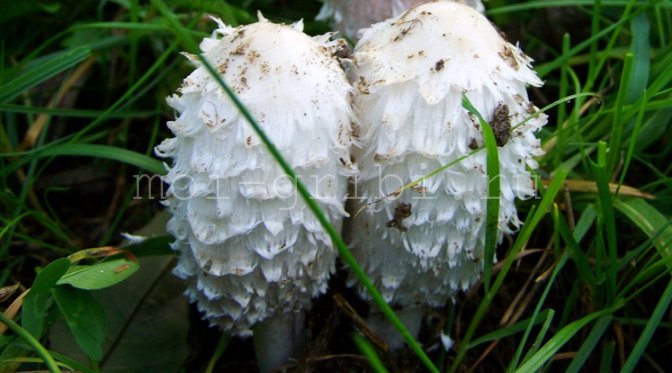
Interesting Facts
Dissolving, the mushrooms form a liquid stain or dark gruel. It used to be used instead of ink. Hence the second common name for dung beetles is ink.
- The process of decomposition of the dung beetle cap does not occur under the influence of external factors, but due to the enzymatic reaction of the fungus itself, autolysis.
- It is not for nothing that the dunghill is called the ink mushroom - before it was used to make ink and ink.
At one time, ink was made from the black liquid into which overripe dung beetles turn to draw up especially important state documents. The fact that the document is genuine was evidenced by the spores of fungi, clearly visible if the signatures are examined under a microscope.
Thus, dung beetle is not a very famous mushroom, but it is quite worthy of the honor to be in the basket, on the table, and even in a medical recipe. Its valuable properties are very diverse.
The very name of the mushroom - ink - is no coincidence. It was from it that people learned to get ink back in the old days. Moreover, they were not available to everyone due to their price and quality. They were used only for important documents and bills of exchange. The use of mushroom ink protected documents from forgery due to the different patterns of disputes on the papers. At the same time, for comparison, it was necessary to have a sample of the ink itself.
The "inkiness" of mushrooms is explained by the process of maturation of spores. More often than not, they ripen, dry out and are carried by the wind. In the dung beetle, another process takes place - autolysis.
It lies in the fact that as the mushroom matures, it begins to self-digest. As a result of such aging, a dark puddle with spores forms at the site of the fruiting body. If it rains, it will wash away these spores and spread them around. This "digested" liquid was used in the manufacture of ink.
White
Appearance.The cap has an elongated ovoid shape at the initial stage, and an elongated domed one after maturation. Height varies within 5-20 cm, diameter - from 5 to 10 cm. Painted in white or grayish color, dark scales of small size are visible on the surface of the skin. The top of the cap may be light brown. The pulp is white and has no perceptible taste or smell. The plates of young mushrooms are pure white, wide, located freely. When ripe, they first turn pink, and then completely blacken during self-digestion.
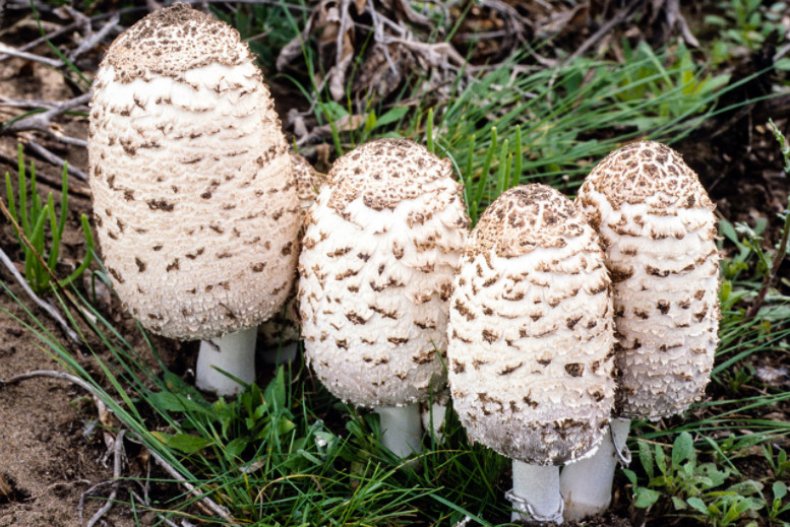 Coprinus comatus
Coprinus comatus
The real length of the leg is from 10 to 35 cm, but the visible part does not exceed 10 cm in length, since 2/3 of the legs are hidden under the dome of the cap. White, hollow inside. The base of the leg, which is in the ground, has a thickening.
Where it grows. It is found everywhere in the temperate zone of the Northern Hemisphere. Prefers humus-rich soils, and grows in large quantities on pastures and near farms. It is difficult to meet white dung beetles in the forest, while they can appear in landfills and garbage dumps
It is important for the fungus that the substrate is rich in plant or animal debris. Seasonality and edibility
White dung beetles appear in March and disappear from the fields in late or mid-autumn (depending on the region). Mushrooms are collected only on clean soils, away from landfills and various enterprises. The collection is carried out after the rain, since the fruit body must be young so that it can be eaten without fear.
In autumn, you can pick edible mushrooms such as porcini mushroom, oyster mushroom, milk mushrooms, umbrella, goatling, chanterelle, butter dish, flywheel, honey mushroom, boletus, boletus, mushroom, ryadovka.
Usage rules. Remember that this mushroom is completely edible only until the fruiting body is ripe. After ripening, it is dangerous to eat dung beetle. The species is characterized by the fact that after maturation, it begins to digest itself, releasing special substances. As a result, old mushrooms can be considered rotten, and a rotten product cannot be safe.

Despite the edibility, it is recommended to boil the fruit bodies before eating. After that, you can fry, stew, salt or pickle. Immediately after collection, the fruit bodies must be processed as soon as possible, since the self-digestion process does not stop even at negative temperatures. It is also worth remembering that you cannot store and store dung beetles with other mushrooms, otherwise they will also start to rot.
Important! Old sources indicate that white dung beetle can cause poisoning when consumed with alcohol. This is a misconception
Description of hairy dung
In a young mushroom, the shape of the cap is fusiform-elliptical, but after a day it opens and becomes bell-shaped, after a while it becomes almost flat with raised edges.
Even at the bell-shaped stage of the fungus, autolysis begins, that is, self-dissolution of the cap. Therefore, only the central part of the cap reaches the flat stage. The diameter of the spindle-shaped cap is small - 1-2 centimeters, while the height of the cap is 2-4 centimeters.
The surface of the cap is densely covered with small white flakes; this is the remnants of a common torn. The flakes are similar in appearance to the pile. An olive-brown surface is visible between the sparse flakes.
The flesh of the cap is fragile, very thin, rapidly decomposing. Plates, narrow, free, often spaced. In the first hours of the life of the fungus, the color of the plates is light gray, but then they turn black and turn into mucus. The color of the spore powder is violet-black.

The height of the leg is about 8 centimeters, while its diameter is 0.5 centimeters. Its shape is cylindrical, it is often curved. The surface of the leg is covered with light scales.
Places of distribution and fruiting time of fluffy dung beetles
Hairy dung beetles bear fruit in summer and autumn. They grow in a wide variety of places, while settling on the thoroughly rotten remains of deciduous trees.Sometimes these fungi can be seen on well-fertilized soil.
The fruiting bodies of fluffy dung beetles develop and dissolve very quickly. This mushroom can be recognized only in the first hours of its life, so there is no clarity about their distribution.

Similar species
The genus of dung beetles abounds in similar species. The short life span of these fungi and the blurring of their external data greatly complicates the analysis.

Other dung beetles
Snow-white dung is an inedible mushroom. The size of its cap does not exceed 3 centimeters in diameter. At first, the shape of the cap is ovoid, and then it becomes conical or almost flat. The skin of the cap is pure white with a thick mealy bloom. The leg is very thin and light.
These mushrooms grow on horse manure. You can find them among the wet grass. Snow-white dung beetles bear fruit from summer to autumn.
Gray or ink dung is a conditionally edible mushroom. Its cap varies from ovoid to bell-shaped. The surface of the cap is dotted with small scales. Its height reaches 7 centimeters with a width of no more than 5 centimeters. The leg is long, fibrous, white, without a ring.

Gray dung beetles grow in the grass, on fertilized soils and on stumps. Often found in large groups. Fruiting from spring to autumn. When gray dung beetles are consumed together with alcohol, slight poisoning occurs, since they contain substances that are incompatible with alcoholic beverages.
Interesting facts about the mushroom

In Russia, dung beetles were unpopular for a long time, they were called "toadstool", but, for example, in the Czech Republic, Finland and France, these mushrooms have long been highly valued and considered a delicacy.
Gray and white dung beetles were used to make ink. Ripe mushrooms were put in a bowl and the liquid obtained after autolysis was filtered and glue and clove oil were added to it as a flavoring
Such inks were added to the usual ones as a means to protect documents of state importance, bills of exchange. After drying, the spores of the fungus form a unique pattern, which was examined under a microscope and manually fixed.
Gray dung causes poisoning in people who are intoxicated, but the mushroom remains harmless for non-drinkers
Thanks to these properties, the type of mushroom is used as an anti-alcohol agent.
White dung beetle (Coprinus comatus)
or
Ink mushroom
Dung beetle (Latin Coprinus comatus) is a mushroom of the genus Dung (Latin Coprinus) of the Dung family.
Hat:
Height 5-12 cm, shaggy, white, fusiform at first, then bell-shaped, practically does not straighten. There is usually a darker bump in the center of the cap, which, like the captain, is the last to disappear when the cap of the mushroom comes out on the ink. The smell and taste are pleasant.
Plates:
Frequent, free, white, turn pink with age, then turn black and turn into "ink", which is characteristic of almost all dung beetles.
Spore powder:
Black.
Leg:
Length up to 15 cm, thickness 1-2 cm, white, hollow, fibrous, relatively thin, with a white movable ring (not always clearly visible).
Spreading:
White dung is found from May to autumn, sometimes in enchanting quantities, in fields, vegetable gardens, orchards, lawns, in garbage dumps, dumps, dung heaps, as well as along roads. Occasionally comes across in the forest.
Similar species:
White dung beetle (Coprinus comatus) is almost impossible to confuse with anything.
Edibility:
Great mushroom. However, it should be remembered that you can only pick mushrooms that have not yet begun to fulfill their Great Mission - to self-digest, to turn into ink. The plates must be white. True, nowhere is it said what will happen if you eat (eat, as they say in special editions) dung beetle, which has already started the process of autolysis. However, there are hardly any who wish. It is believed that white dung is edible only at a young age, before the staining of the plates begins, no later than two days after it emerged from the soil.It is necessary to process it no later than 1-2 hours after collection, since the autolysis reaction continues even in frozen mushrooms. It is recommended to pre-boil it as conditionally edible, although there are claims that the mushroom is edible even in its raw form. It is also not recommended to mix dung beetles with other mushrooms.
It should also be noted that according to scientific data, garbage saprophytes like dung beetles with special enthusiasm pull all kinds of harmful products of human activity from the soil. Consequently, it is impossible to collect dung beetles in the city, as well as near highways.
By the way, it was previously believed that Coprinus comatus contains substances incompatible with alcohol, and therefore, in a sense, poisonous (although, for that matter, alcohol itself is poisonous, not the mushroom). Now it is quite obvious that this is not the case, although sometimes this old delusion pops up in the literature. Many other dung beetles like Gray (Coprinus atramentarius) or Shimmering (Coprinus micaceus) are advocating a healthy lifestyle, although this is not certain. But the White Dung, fortunately or unfortunately, is deprived of this property. That's for sure.
Notes: I have many childhood memories associated with the dung beetle. In the second class, in the fall, I somehow unexpectedly became a big enthusiast of "city mushrooms", spending whole days in search of dung beetles and champignons. I knew all the yards in my neighborhood, I had a lot of volunteers. They laughed at me, of course, but for some reason they willingly helped.
At home my inclinations were fully supported. Oddly enough, in terms of mushrooms, they completely trusted me even then, and every autumn for several years in a row dung beetles and, less often, champignons appeared on our table. Dung beetles stewed in sour cream, and cheese on top - it's impossible to forget. How I began to collect them and why I stopped - I definitely don't remember, but dung beetles in sour cream ...
False doubles
The common dung beetle has no false counterparts. It is possible to mention only a few poisonous mushrooms that have some similarity with him, and even then very distant (see photo).
| Name | Inhabits | Hat | Leg | Pulp |
| Home dung
(young mushrooms are not poisonous) |
Dead trees, fertile soil | In young mushrooms - pale yellow, then yellowish-brown, scaly. | Long, white, widened at the base | White |
| Paneolus (dung beetle) bell-shaped
Poisonous |
Grows in groups on rich soils, dung heaps. | Greenish gray, dark in wet weather. There is a tubercle at the top. The edges are uneven, with white teeth. The plates are frequent, adherent, gray or blackening. | Long, thin, gray. | Pale gray |
| Paneolus (dung beetle) moth
Poisonous |
Grows in groups on old manure. | Dark brown or brown-gray, brightens in older specimens. The plates are rare, adherent, speckled black color.
Spores are black. |
Long, thin, brittle, gray or dark brown. | The pulp is odorless, creamy or brown. |
| Paneolus odorous
Poisonous |
Grows in large groups in grass, on rich soil. | Reddish brown, smooth or hemispherical. The plates are rare, creamy.
Spores are dark brown. |
Straight, red-brown, light. | The pulp is dense, brown, with a pleasant smell. |
Gray
Another name is ink.
Appearance. The diameter of the cap is 5-10 cm. The shape of young mushrooms is ovoid, and of mature ones it is bell-shaped. The skin is gray with a reddish tint. There are small scales on the surface. The pulp is very thin, light, darkens quickly upon contact with air. No smell, sweet taste. The leg is long, 10-20 cm, thin, hollow. The surface is painted light gray. The plates are white, free, in mature mushrooms they are black.
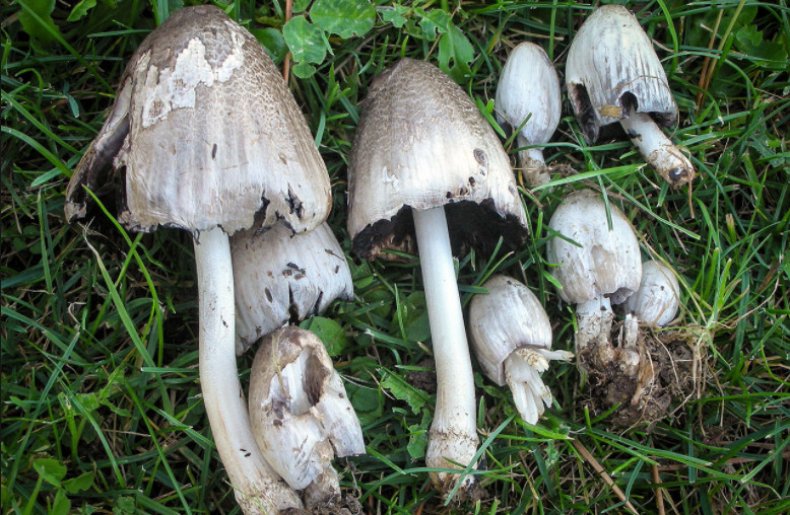 Coprinopsis atramentaria
Coprinopsis atramentaria
Where it grows. The fungus prefers humus-rich soil, therefore it is found in large quantities on farms, as well as in grazing areas. In the forest, it grows near rotten or decaying trees. Can grow in a vegetable garden or garden if conditions are acceptable.
Seasonality and edibility. Appear from May to October.Mushrooms grow in small groups. Gray dung beetle is classified as conditionally edible mushroom. Only young specimens with light plates can be eaten.
Usage rules. After preliminary heat treatment, which is carried out as soon as possible after harvest, the mushrooms can be fried, stewed, salted or pickled. Drying is not carried out.

Note that gray dung beetle is in some cases used as a remedy for alcoholism, since when consumed together with alcohol, it causes poisoning with very unpleasant symptoms. Poisoning will occur even if the blood contains a small dose of alcohol breakdown products.
Video: cooking gray dung
Did you know? Dung beetle is used to obtain ink. It is left in a vessel until it decomposes completely, after which it is filtered and glue is added. After drying, such ink gives a special pattern, therefore, it is used to protect bills of exchange and important documents from forgery.
Description
Butterfly paneolus (Panaeolus papilionaceus) is a lamellar mushroom, belongs to the genus Paneolus, the Koprinovye or Dung family.
- the cap is small, convex in young fruiting bodies, bell-shaped in adults, with a diameter of 1 to 4 cm. Skin color is gray-brown or dark gray, with age it looks lighter in relation to the leg. The edges are covered with small whitish triangular scales - these are the remnants of the bedspread, over time they become almost invisible. The tubercle in the center of the cap is yellowish or brown in color. The cap is smooth and dry to the touch, but becomes slightly sticky when it rains;
- the flesh of the leg is dark brown in color, the cap is soft cream. Thin, does not have a special smell;
- the leg is thin, long (from 4 to 12 cm), fragile, up to 3 mm in diameter. Occasionally expands towards the bottom, but generally of the same thickness along its entire length. There is a cavity inside. The color is gray at first, dark brown as it matures. In young paneolus moths, a white bloom is present on the leg;
- plates are rare, wide, most often adherent to the stem. The color is dark, sometimes almost black, with a marbled pattern. On the edges of the plate are lighter;
- spores are black, elliptical in shape.
Description and photo
The mushroom has a nondescript appearance, it is not so easy to notice it in the forest, since the funnel does not stand out in any way. Translated from Latin, it is called Craterellus cornucopioides. Some specimens grow from 5 to 12 cm. Names in Russia: gray chanterelle, funnel-shaped funnel, gray funnel.
Hat
The mushroom has a cap, which is 3 to 5 centimeters in diameter, but there are funnels, in which the cap reaches 8 cm. The edge of the cap is sinuous, and it itself is wrapped in a tube, smoothly turning into the base. From the visual point of view, it may seem that the mushroom changes its appearance in different weather.
At high humidity, the funnel-shaped funnel looks dark, its color is dominated by such colors as black-brown or just black. In sunny weather, its shade becomes slightly lighter, and the cap becomes gray-brown or light brown.
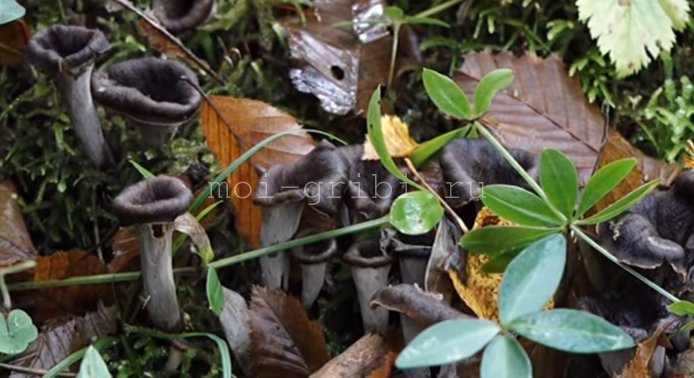
Leg
The fluffy head of the funnel is supported by a strong leg, which can be from 5 to 7 centimeters, but in some mushrooms it can even reach 10 centimeters, and its diameter is on average 1 centimeter. Inside, it is completely empty and consists of tubular fiber. Compared to the cap, the stem of the mushroom is quite firm and elastic. Its color is brownish, and in some it is darker, closer to a black shade.
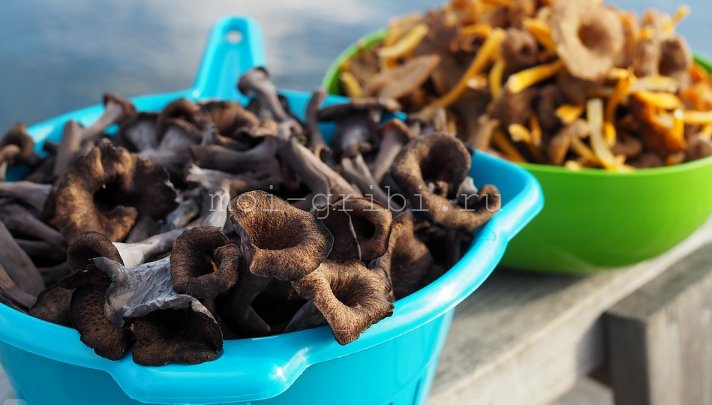
Pulp
The flesh of the horn-shaped crow is quite tender and fragile, it is very easy to damage it, and in appearance it resembles a film. It is predominantly gray in color, but if boiled, it will acquire a rich black hue.
Edibility
Indigenous Europeans consider this mushroom a delicacy. To prepare it, you do not need to heat the mushroom at all. But not the entire funnel-shaped funnel is edible, they eat only the hat, since it is softer, the leg is not eaten.
This unique nutritious product can be added to fried or stews, soups, and a variety of seasonings and sauces. It takes only 10 - 12 minutes to boil a mushroom cap, in addition, it is often dried and ground into a powder, which is later used as an additional ingredient that gives aroma and taste.
Its cost is not cheap, if you want to buy a dry mushroom, you will have to pay a tidy sum, about 1,000 rubles per 100g.
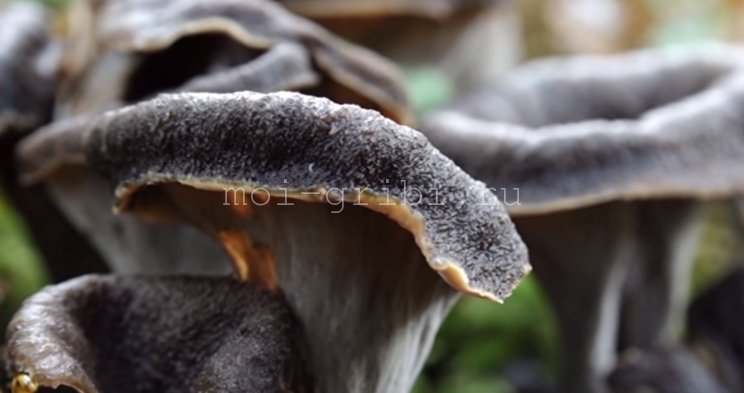
Description
Ink mushroom - he is gray dung or ink dung. Scientific name Coprinopsis atramentaria or Coprinopsis atramentarius. Belongs to the genus Dung or Koprinus (Coprinus) of the family Dung or Psathyrellaceae. Popular English name - Alcohol inky cap - alcoholic ink cap.
The cap is 5 to 10 cm in diameter, 4 to 10 cm high. In a young mushroom, it is at first ovoid, wrinkled, and then rapidly opening into a wide-bell-shaped, with cracking edges. In adulthood, it turns up. The color of the cap is whitish-gray, gray or dirty brown. The middle is darker than the edges. Its surface (especially the center) is covered with small darkish scales.
The hymenophore (the lower part of the cap, bearing a thin spore-bearing layer of hymenium on the surface) is white, lamellar. The plates are wide, frequent, and uniform in length. On the cut - flaky.

Its pulp is light, very fragile, but darkens quickly at the site of a cut or break. It has a weak, pleasant smell and sweetish taste.
The leg grows in height by about 10–20 centimeters. In diameter - from 1 to 3 centimeters. White, slightly brownish at the base with a thickening, smooth. It has a cylindrical shape, most often curved and hollow inside.
A bit of history
For the first time in history, dung beetles were described by Danish scientists Otto Frederik Müller (1730 - 1784). And at the end of the eighteenth century, mycologist Christian Heinrich Persons from the Netherlands transferred the ink mushroom to a new family of lamellar or agaric (Agaricaceae).
The dung beetle cap resembles a bell in shape, the pulp is fibrous. The top is abundantly covered with scales, resembling flakes. Thin plates change color from white to black with age.
The thin leg is very fragile, hollow inside.
Thin-bodied, the flesh is practically absent. Black oval spores. It grows extremely quickly, in a matter of hours, and in some cases the full ripening cycle is no more than one hour.
Ripening, the cap dissolves (autolysis), a gruel or an ink-colored spot in the form of a ring forms in place of the fungus. Autolysis continues after harvesting, so it is impossible to store fresh mushrooms, even frozen. Immediate heat treatment is required.
Edible only while young, identified by white plates. Therefore, the dung beetle belongs to conditionally edible mushrooms. If the plates begin to turn yellow or pink, the mushroom is no longer suitable.
Saprotroph, i.e. helps to decompose organic residues.
Loves soil rich in organic remains, fertilizers, found on rotting trees, stumps. Collection time from May to October.
Hat
The flesh of the cap is thin, the cap is fibrous to the touch, covered with large white scales. The cap of a young mushroom is conical, almost fusiform, with edges closed at the stem. As the mushroom grows, the cap opens a little, taking the shape of a bell, very rarely - it opens to the state of an umbrella. There is a gray or brownish tubercle in the center of the cap. The pulp of a young mushroom is tender, white, with a weak mushroom aroma and unexpressed taste.
Spore-bearing layer

White, rather thin, covered with velvety scales. The inside is hollow, the flesh is also white, the old mushroom is creamy, without any special smell or taste. In thickness it reaches one and a half centimeters, in height up to 15-17 centimeters. There is an easily movable ring on the leg, however, as it grows, it quickly disappears. At the base of the leg there is a characteristic “sac” (the so-called vagina)

